In 2024, MIT CISR proudly celebrated its 50-year legacy. Throughout the year, we shared memories and milestones from MIT CISR's history of practice-based research and industry and academic collaboration on this webpage.

50 Facts from 50 Years
On October 28, 2024 MIT CISR celebrated its 50th Anniversary with family and friends around the world in a Gala Program that was simulcast and recorded.
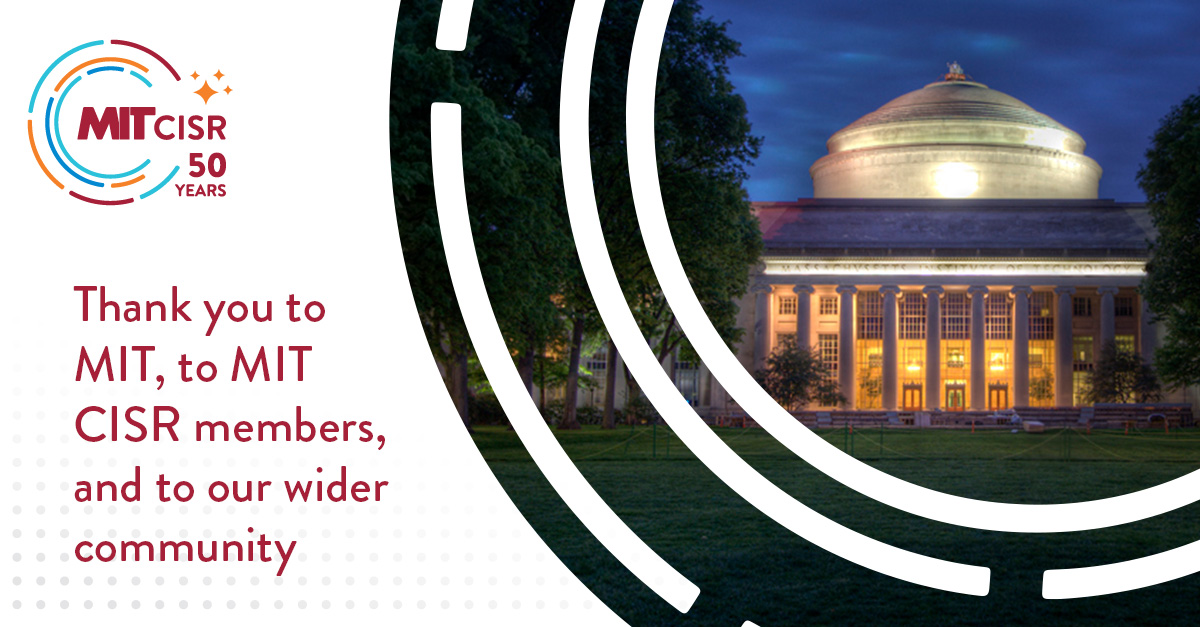
MIT CISR is fortunate and proud to be part of a rich and exciting research environment like MIT. MIT faculty, scientists, and students do amazing research that yields fundamental knowledge and practical applications, and that research informs the work we do at CISR. We have also benefited from the leadership, support, and encouragement of the MIT Sloan School, including the deans and our colleagues in the IT group. We are grateful to the MIT community for the supportive environment and the sharing of ideas.
And thank you to the companies and organizations that have been, and are currently, MIT CISR sponsors and patrons. Their support goes beyond funding our research to offering access, providing data, and agreeing to be case study examples—the stories that make MIT CISR frameworks come to life. Their leaders have a passion for the opportunities and challenges that IT, data, and digital create, and a willingness to share experiences and debate ideas. This helps us develop insights and understand best practices and it is an honor to be part of these conversations.
This is the last entry in our series of MIT CISR 50 Facts for 50 Years. It has been a delight to compile these memories and milestones and to hear from the MIT CISR community about your enthusiasm for MIT CISR! Please stay in touch.
• See more about MIT.
• See more about MIT Sloan School of Management.
• View the list of our Consortium members.
#MITCISR50th #MITCISR

These MIT CISR 50th anniversary recollections have given us an opportunity to revisit research projects, highlight important research findings and most importantly, remember colleagues from over the years. And moving forward, we have great team in place to help make CISR 3.0: Innovate, Excite, and Scale a reality. The MIT CISR research team, Peter Weill, Stephanie Woerner, Barb Wixom, Alan Thorogood, Ina Sebastian, and Nick van der Meulen, along with industry and academic collaborators, are eager to identify new, exciting research questions, explore those questions via surveys, interviews, and other methods, and then synthesize results into best practices and frameworks that companies can use.
Supporting the research team and our consortium members is the MIT CISR administrative team, among the best in the business. Chris Foglia, our Associate Director, leads the administrative team—and oversees the consortium member processes and platforms as well as events and financial analysis and control. Cheryl Miller manages our research content production and technology, getting the briefings out every month like clockwork and ensuring the website works smoothly. Bel Byerly-Chapman works with Chris and Cheryl (and we’ve discovered she has deep talents in design and video editing). Maggie Di Pinto supports Stephanie and Barb, and helps Barb run the Data Advisory Board. Austin Van Groningen manages member engagement, adding new capabilities and processes to our member interactions, and helps bring new member offerings like Learning Programs to life. Dorothea Gray assists Peter and works with Austin on member engagement. Together, we at MIT CISR are looking forward to many more years of working and sharing with our members and the wider community.
• See more about the CISR Research Team.
• See more about the CISR Admin Team.
#MITCISR50th #MITCISR
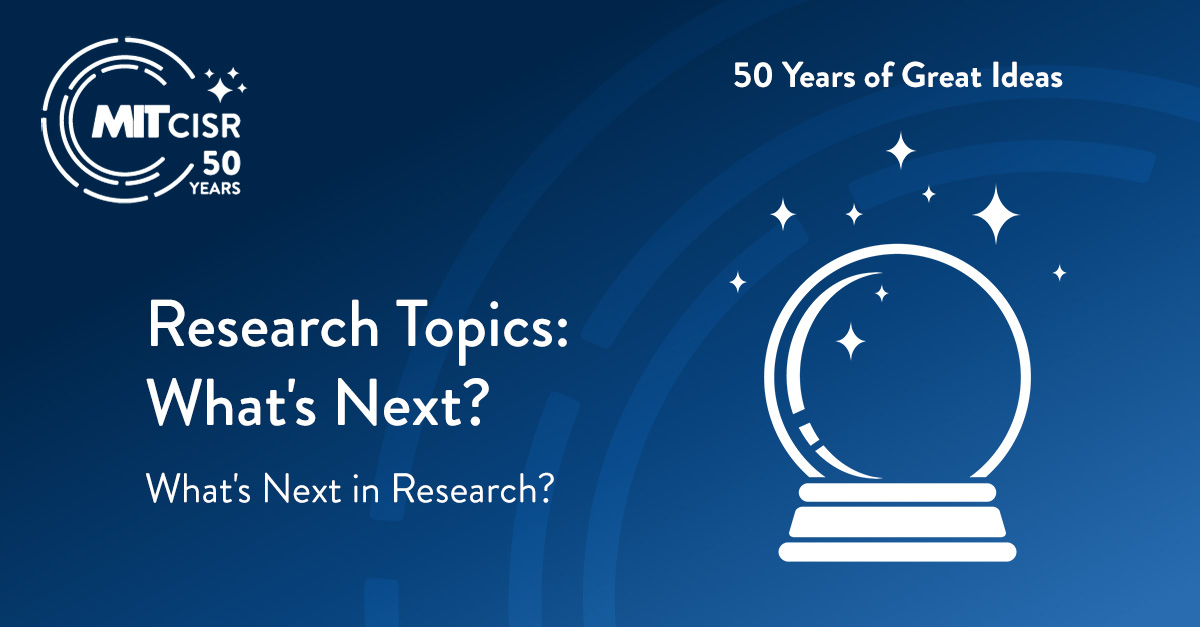
For the last 50 years MIT CISR has been studying how bigger, older companies integrate the newest technologies to drive business value, and then we work together with our member companies to help them generate that value. We took a moment to think about what's coming in the next ten years. Here are our top four ideas.
1. Welcome to the world of DigiReal
The merging of the digital and physical world via AI will reshape everything from supply chains to customer experience. There will be a merging of physical and information value chains, resulting in an integrated value network. In “Optimizing Your Digital Business Model,” we hypothesized that digital technologies allowed companies to decouple their content, experience, and platforms, creating three distinct sources of competitive advantage. AI and connectivity are enabling companies to reexamine those separate sources and identify new combinations to leapfrog their competitors.
2. The digital employee?
Both work and workplaces are changing. How people work is affected by technology and with the explosion of AI and data, we expect to see the reinvention of jobs and changes in how enterprises organize. Some work is going to be done by the combination of humans and AI. Some work is going to be automated, with decisions delegated to autonomous agents. What work and decisions need humans in the loop? What does an electronic full-time employee cost?
3. It’s time to create a capability balance sheet.
How to account for labor and intellectual capital is a long-standing issue when valuing companies. The rise of digital technologies and the accompanying value of a company’s data and automated business processes changes how companies are valued. More and more, a company’s capabilities distinguish it from its competitors. What will be the key assets of the enterprise? We think people, platforms, data, and partnerships will begin to be valued and contribute to market capitalization.
4. Rethink the role of the IT unit.
The role of the CIO and the IT unit has been expanding over the years to include digital, data, AI, compliance, customer experience and cybersecurity. In ten years there will be a few core activities IT will have to do—key enterprise-wide assets like enterprise architecture, shared platforms, connectivity, cybersecurity, data access, leading edge technology and perhaps operations. If we are right, we need to increase the digital savviness of the entire enterprise—an important role for IT and HR. We think many CIOS will have P/L responsibilities for some digital products and services to generate new value.
Since predicting the future is notoriously unreliable, we'd love to hear your thoughts. Please join the conversation.
#MITCISR50th #MITCISR

What’s next for MIT CISR? We are delighted to launch CISR 3.0: Innovate, Excite and Scale. As Jack Rockart used to say, “IT is a team sport” and in the digital era, the IT “team” has expanded to include the entire organization. MIT CISR will continue to do cutting-edge, innovative research about top-performing companies that excites and inspires. But we want that research to touch everyone in a company. We are modularizing and curating our research so companies can more easily scale a common language throughout the enterprise and nurture digitally savviness. As part of CISR 3.0 we developed a suite of offerings to help companies become Future Ready; please write to cisr@mit.edu if you’d like more information. MIT CISR and our members are a passionate community of learners—here’s to a great 50 years to come!
#MITCISR50th #MITCISR
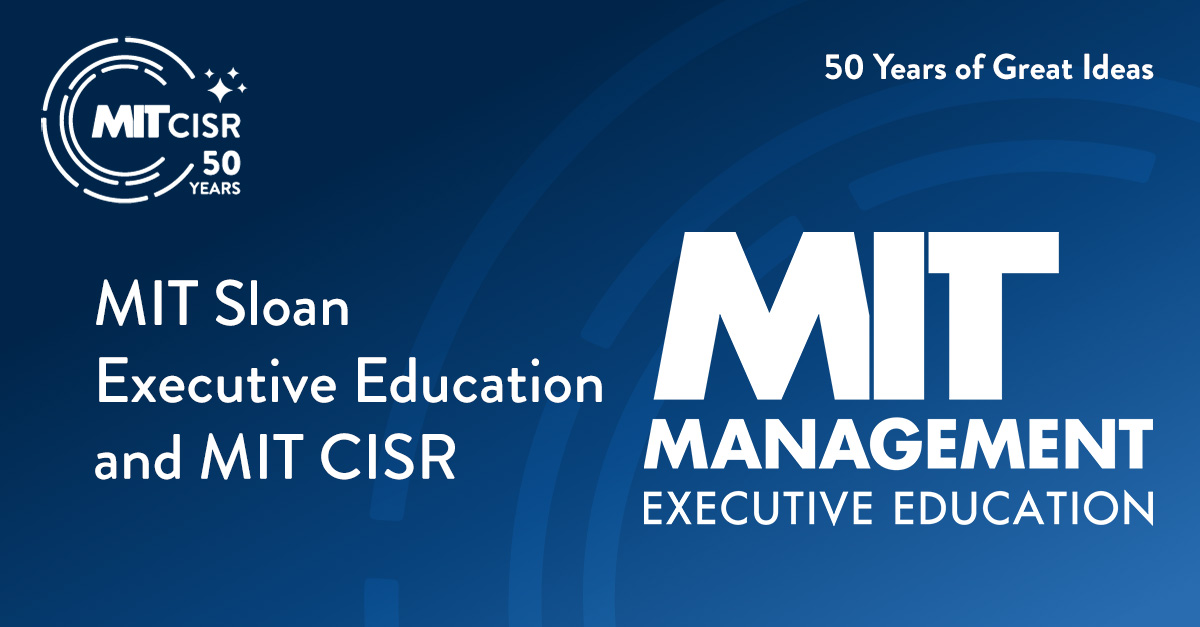
The relationship between MIT Sloan Executive Education and MIT CISR is long and enduring. Jack Rockart taught in many custom executive education programs over the years. When Peter Weill joined as director, he envisioned working more closely with senior management teams and boards to create and embed a common language around IT and digital transformation in their enterprises. Peter instituted ½-day workshops delivered by CISR as a way to engage senior teams and boards, but for longer term engagements and access to a wider expertise, MIT CISR partners with MIT Sloan Executive Education. The MIT CISR team has led many custom MIT Sloan executive education programs for our members and we’ve found that those programs strengthen the learnings, support transformations, and cascade the learnings deeper into the enterprise. Custom programs that MIT CISR has collaborated on include ANZ Banking Group, Commonwealth Bank of Australia (CBA), and Standard Bank Group of Africa. MIT CISR researchers work in the custom executive programs for sponsors, in ongoing custom programs, and in open enrollment programs such as “Becoming a More Digitally Savvy Board Member” and "Digital Strategies for Transforming Your Business." The MIT CISR collaboration with MIT Sloan Exec. Ed. is a win-win for all participants.
• Learn more about MIT Sloan Executive Education
• See more on Becoming a More Digitally Savvy Board Member
• See more on Digital Strategies for Transforming Your Business
#MITCISR50th #MITCISR
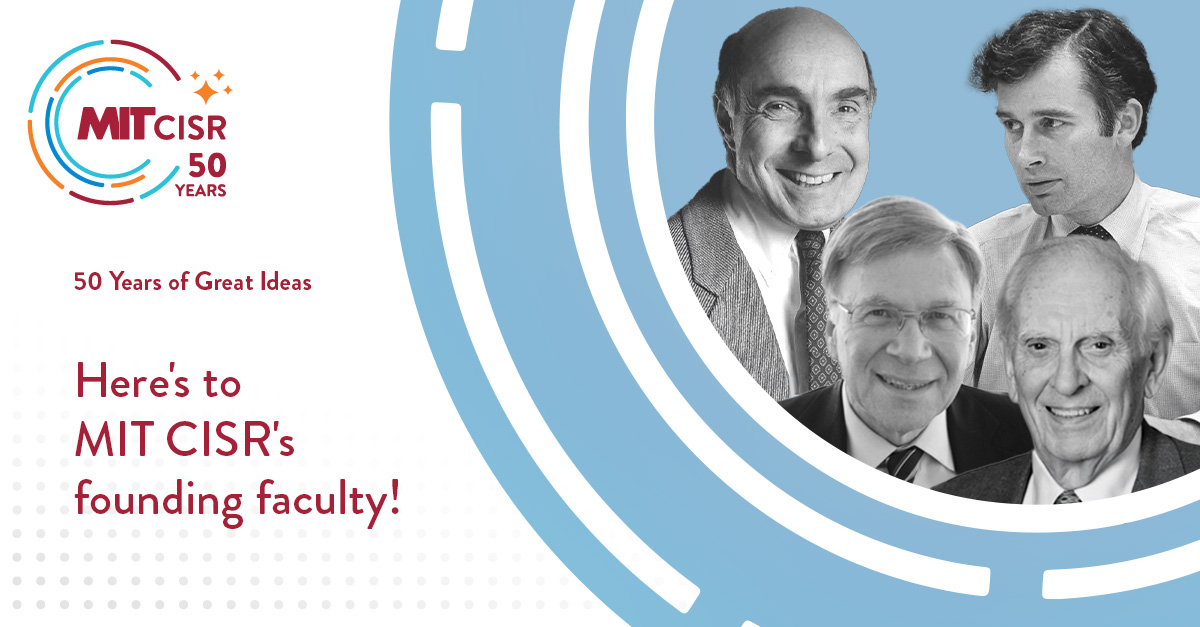
Back in 1974, some brilliant minds at the MIT Sloan School came together to create something truly special and MIT CISR was born. The Center for Information Systems Research was established at the MIT Sloan School of Management to define, research, and report on significant managerial issues in the utilization of computer-based information systems and 50 years later, MIT CISR is still doing just that. Of course, technology has changed significantly—from green screens to ChatGPT—but MIT CISR's mission remains true to the vision of our founders including Michael Scott Morton, John F. (Jack) Rockart, and Stuart Madnick, with the strong support of William Pounds, Dean of MIT Sloan at the time.
#MITCISR50th #MITCISR
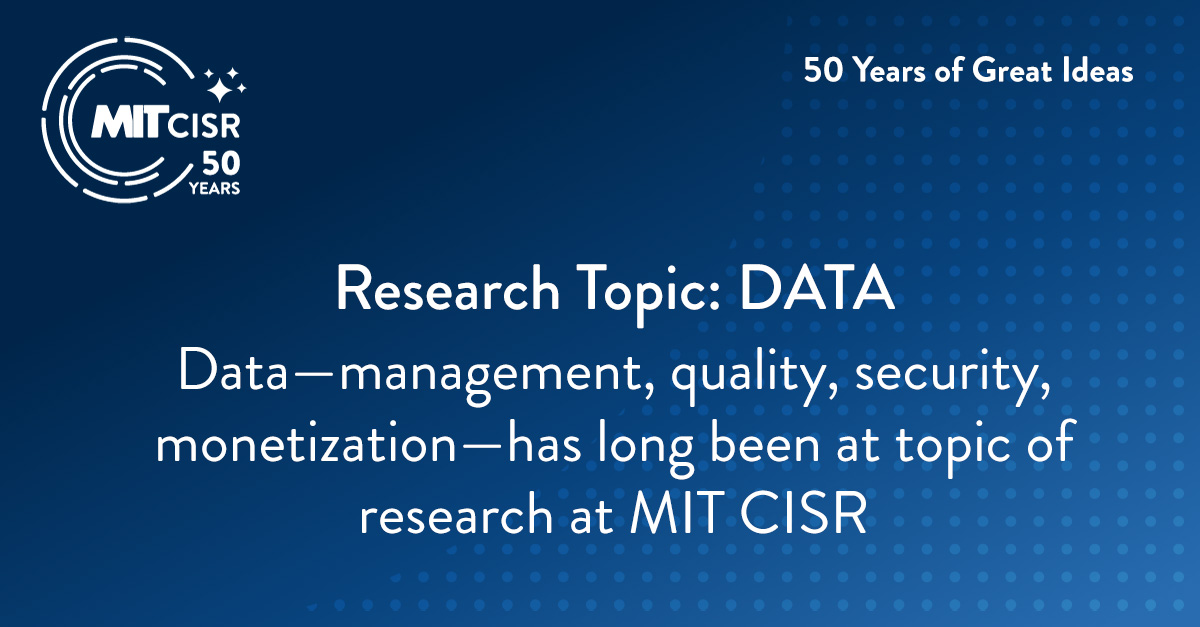
Data has been a main focus of CISR research across the years. At CISR’s inception, Prof. Stuart Madnick was developing new approaches to database architecture and the logical and technical connectivity of databases. He and MIT colleagues went on to research how to improve data quality and data security. In the late 1970s, Jeffrey Meldman began to study data privacy.
In the 1990s, as organizations became increasingly aware of the value of data as a corporate asset, CISR’s director, John F. Rockart, launched a project focused on effective approaches to managing and leveraging corporate data. Based on 30 case studies of data management initiatives undertaken by organizations to solve concrete business problems caused or exacerbated by poor data, the study found a range of successful approaches contingent on business context. The results, including actionable insights for managers, were published in a seminal paper, “Managing the Data Resource: A Contingency Perspective” by Dale L. Goodhue, Judith A. Quillard and John F. Rockart, in MIS Quarterly, Vol. 12, No. 3, September 1998.
Barb Wixom began studying data in 1994 during her PhD program, informed by Stu and Jack's earlier work beginning a life-long passion for data research. Barb brought that deep data expertise to MIT CISR in 2012 and established the current ongoing data research stream, connecting past and present research. Data continues to be a strong foundational pillar of MIT CISR.
• See more about Managing the Data Resource.
• Review MIT CISR data research.
• See more about Data is Everybody's Business.
#MITCISR50th #MITCISR
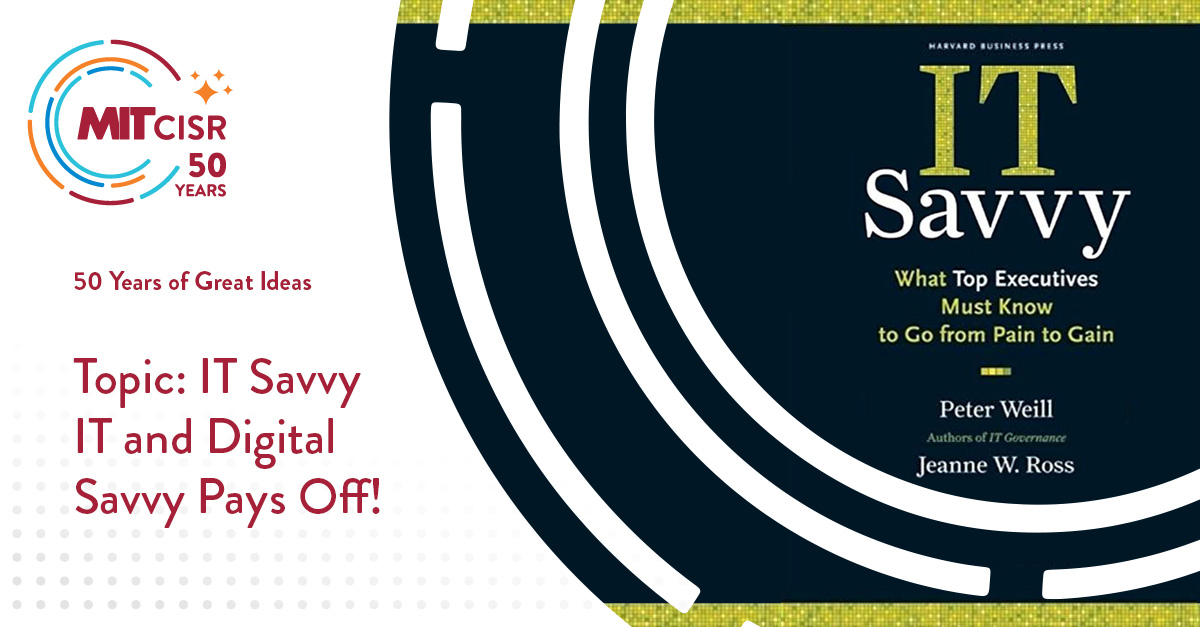
MIT CISR has focused on how companies get value from information technology (and now digital) from its inception. Peter Weill began a research stream, in the early 2000s with Sinan Aral (then a PhD student), that identified the interlocking business and IT practices’ characteristics and competencies that contributed to companies getting that value—they called these interlocking practices IT Savvy. The research showed that companies with high IT Savvy had different IT investment patterns and portfolios, and greater than industry average returns from each IT dollar invested. Anne Johnson and Stephanie Woerner contributed to the early research.
Peter and Jeanne Ross later dug into the practices, competencies, and leadership skills non-IT managers needed to succeed in the digital economy. Their book, IT Savvy: What Top Executives Must Know to Go from Pain to Gain, published in 2009, advised business leaders how to define their companies’ operating model, build digitized platforms, and determine IT decision rights.
Peter and Stephanie Woerner later circled back to studying savviness, finding that the explosion of digital technologies was both an opportunity and a threat to the future success of the company, and raised the bar for all executives, not just CIOs, and for boards. They defined Digital Savvy as 1) insight, tested by experience, of how digital will impact company success, 2) informed by an enterprise level understanding of technology, 3) and knowledge of when to experiment, partner and commit, and 4) ability to balance business model and project risk.
Peter and Stephanie, along with Jenny Banner and Tom Apel, did a study examining the digital savviness of boards of directors in North America, finding that only 24% of boards were digitally savvy; that firms needed three digitally savvy board members to make a difference; and the financial impact of having a digitally savvy board was substantial. Peter, Stephanie, and Aman Shah then tackled the digital savviness of top management teams (TMTs). They found that that among larger companies, only 7% had a TMT more than half made up of digitally savvy members, and those companies outperformed on key metrics. Peter, Stephanie, and Jenny Banner are working on replicating the board study this year and are specifically looking at the role of committees.
• Read about the IT Savvy working paper.
• Read more about the IT Savvy book.
• Read about Digitally Savvy Boards.
• Read about Digitally Savvy Top Management.
#MITCISR50th #MITCISR
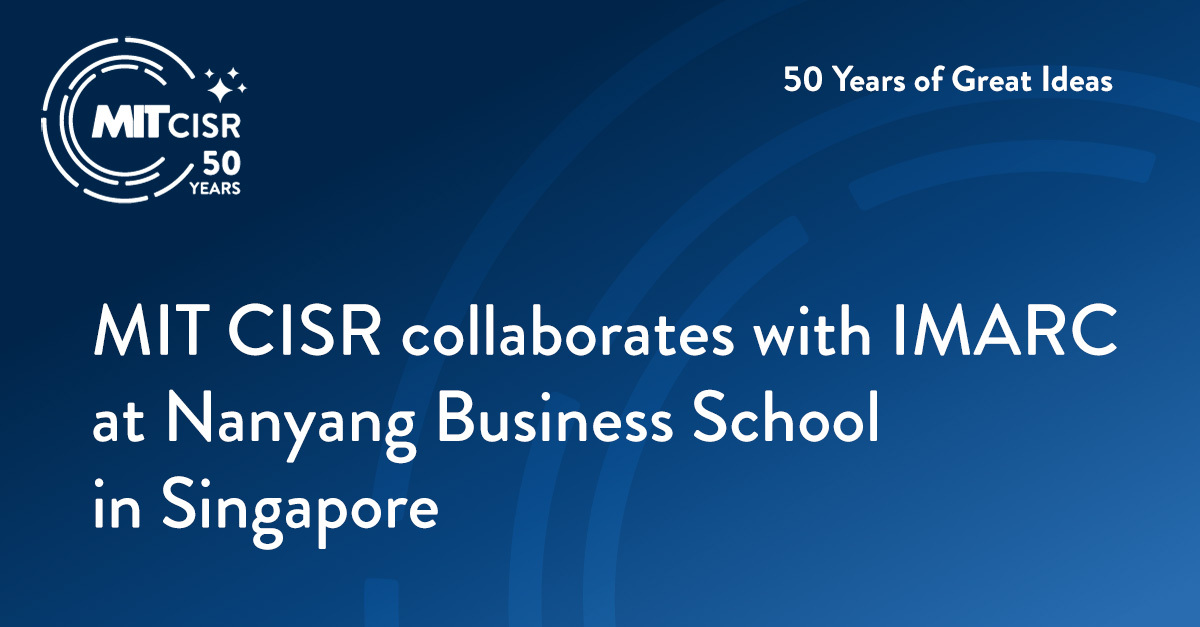
In the early 1990s, Christina Soh and a group of faculty members created IMARC (the Information Management Research Centre) at Nanyang Business School in Singapore to help link researchers in academia with industry colleagues. Jack Rockart and Judith Quillard served on the inaugural International Advisory Board, as did Peter Weill (who was then on the faculty at Melbourne Business School). Peter has studied and written about a number of Singapore companies, including DBS Bank, with Christina and Sia Siew Kien at IMARC and Nanyang. The collaboration continues to be strong.
Read about IMARC.
Read the DBS Bank case study.
Read about DBS Bank as a Future Ready Enterprise.
#MITCISR50th #MITCISR #IMARC
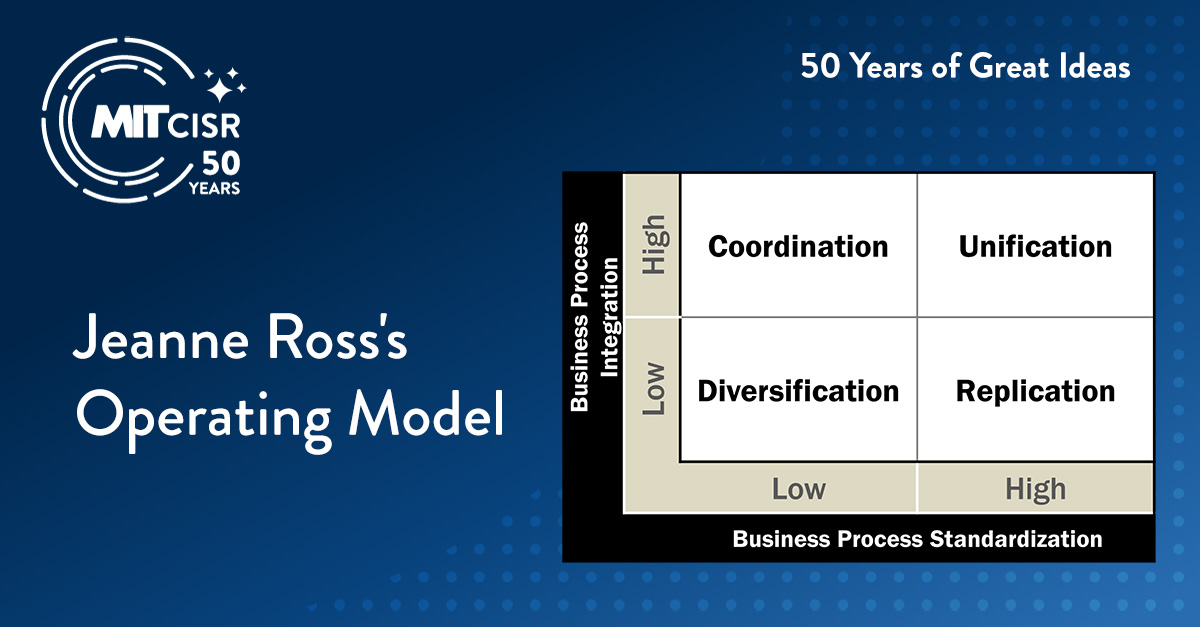
In a 2005 briefing (one of the ten most downloaded briefings over the past 5 years) Jeanne Ross noted that many companies were attempting to maximize value from IT investments by aligning IT with business strategy. But she argued that strategy rarely offered sufficiently clear direction for the development of stable IT and business process capabilities and instead companies should define an operating model. An operating model specifies the necessary level of business process integration and standardization for the company, defining critical IT and business process capabilities.
Jeanne identified two choices that companies have to make: the level of business process integration and the level of business process standardization. These two choices lead to four different operating models. Diversification is a decentralized organizational design with business units pursuing different markets and different products and service. Unification describes a centralized design, standardizing processes and sharing data across the organization. A Coordination model focuses on integration and sharing data while a Replication model focuses on process standardization. Companies have to make a choice as the operating model provides direction for building the reusable foundation for business execution.
• Read the Operating Model briefing.
• Read more about the Enterprise Architecture book.
#MITCISR50th #MITCISR
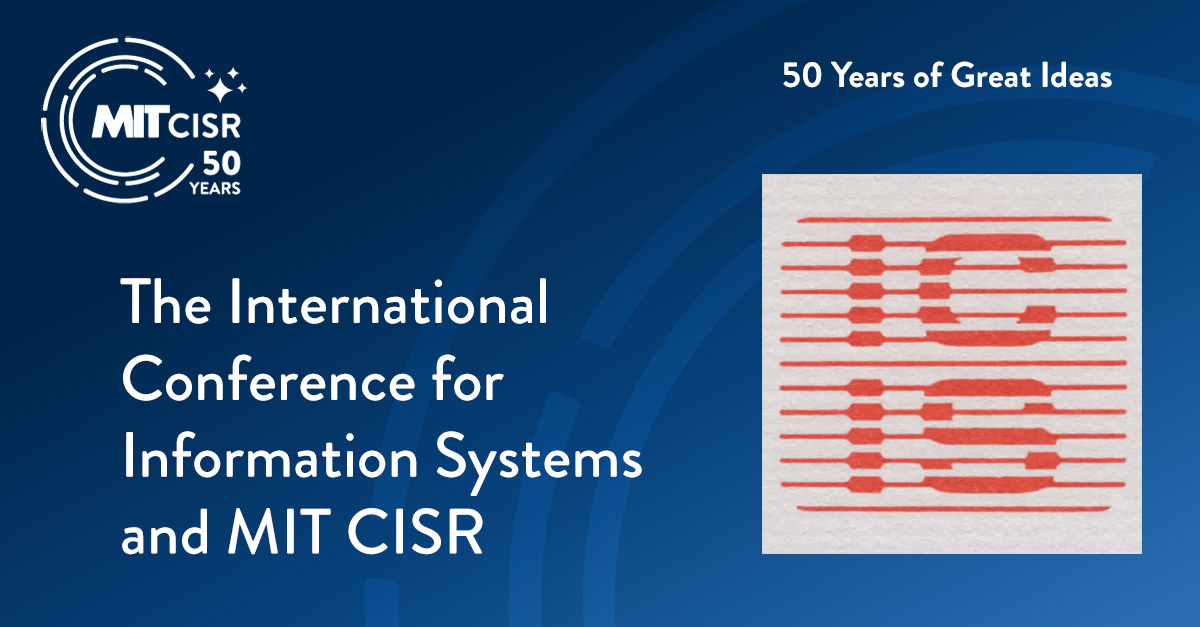
The International Conference for Information Systems (ICIS), now in its 45th year, has become the premier annual event for IS academics and research-oriented practitioners in the world—and CISR has been involved since its beginnings. John F. Rockart, MIT CISR Director at the time, and Christine Bullen, MIT CISR Assistant Director, were part of a group of about 30 IS faculty and researchers from universities across the US who sought to strengthen IS as an academic discipline. With support from several existing academic and professional organizations,* ICIS was launched in December 1980 in Philadelphia with about 150 attendees. The second conference, held December 1981 in Cambridge, Mass., was co-chaired by Jack Rockart with Christine Bullen as conference arrangements and publicity chair. Jack was also the conference co-chair of the 10th ICIS, with Judith Quillard, CISR Associate Director, serving as conference planning and arrangements chair. At this conference in Boston in 1989, attendance surpassed 1000.
CISR and MIT Sloan researchers have continued to be active participants as presenters and organizing committee members for ICIS: for example, Jeanne Ross co-chaired the conference in 2015, and Peter Weill co-chaired it in 2020. ICIS has become truly international in scope and setting, rotating between North America, Europe, and Asia. ICIS 2024 this December will be held in Bangkok, Thailand.
MIT CISR researchers and affiliated graduate students have also won several awards presented at ICIS over the years. Peter Weill won an award from the International Center for Information Technologies, 1989 Washington, D.C., USA for the best doctoral thesis globally in Information Systems in 1988. Sinan Aral won the ACM SIGMIS Doctoral Dissertation Award in 2007, Peter Reynolds won it in 2010, and Arvind Karunakaran, a graduate student supported by MIT CISR, won it in 2018. In addition, MIT CISR research scientists have also won a number of best case study awards.
*The Society for Management Information Systems (SMIS), the Association for Computing Machinery (ACM), The Institute of Management Science (TIMS)
See more about the ICIS conference.
#MITCISR50th #MITCISR #ICIS
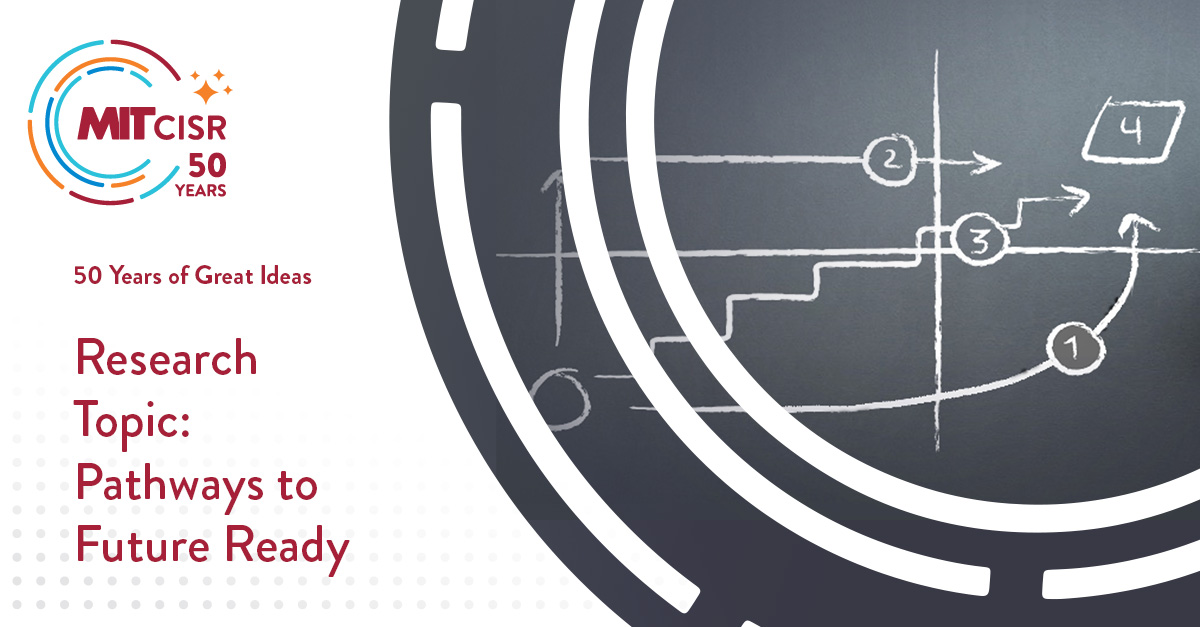
In 2016, Peter Weill and Stephanie Woerner began talking to and working with many leaders who knew they needed to transform their businesses. These executives often didn’t have a good sense of where they were going, or a clear idea of how they would create and capture value from their digital initiatives. This often led to problems such as failure to realize value from digital in their bottom lines, wasted resources and effort, and added complexity and dysfunction. Peter and Stephanie determined that the goal of most digital business transformations is to improve operational efficiency and customer experience. These two dimensions create a 2 x 2 framework that describes four types of firms, with future-ready firms—enterprises that have figured out how to succeed on both dimensions at once, innovating to engage and satisfy customers while reducing costs—in the top right quadrant.
The research then identified four pathways that firms can take to become future ready. Each pathway begins in the bottom left quadrant (silos and spaghetti) and involves significant organizational disruptions—we call them explosions—on the way to becoming future ready.
Ina Sebastian joined Peter and Stephanie to conduct additional interviews and case studies and write the book Future Ready: The Pathways to Capturing Digital Value. The book and the research have been the basis of many presentations and workshops and executives have found that the frameworks help in creating a common language to drive transformation.
• See more about Future Ready.
• Read more about the Future Ready book.
• Read the Digital Pathways publication.
• Read the Digital Business Transformation publication.
#MITCISR50th #MITCISR #FutureReady
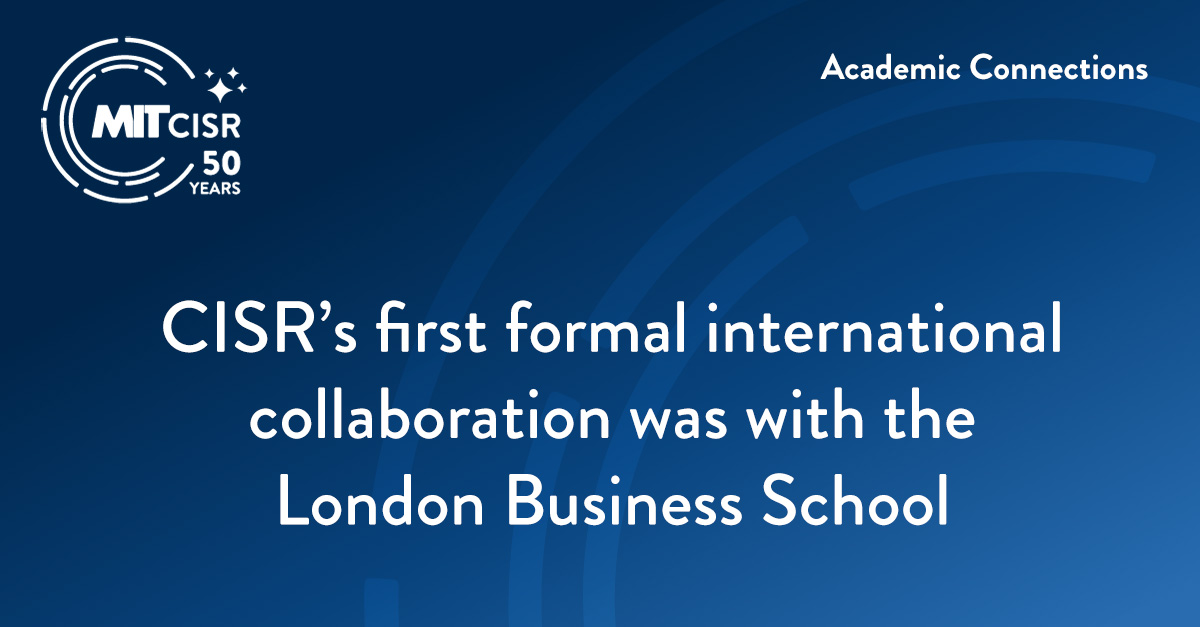
In 1992, a time of rapidly increasing globalization, MIT CISR and the newly established Centre for Research in Information Management (CRIM) at the London Business School (LBS) launched a joint research program. The aim was to bring together an international group of researchers and executives from CISR and CRIM’s sponsoring organizations to advance the theory and practice in the management and use of information technology in global organizations.
CRIM was led by Prof. Michael J. Earl and James E. Short who had been a research associate at CISR prior to his joining the LBS faculty. They recruited a targeted group of corporate sponsors from the UK and Europe. CISR’s director at the time, John F. Rockart, led the program from the MIT side. Other participating faculty included Prof. Jeffrey L. Sampler from LBS and Prof. N. Venkatraman from MIT Sloan. The collaboration included joint workshops for CISR and CRIM sponsors, alternating between the US and UK.
#MITCISR50th #MITCISR #CRIM
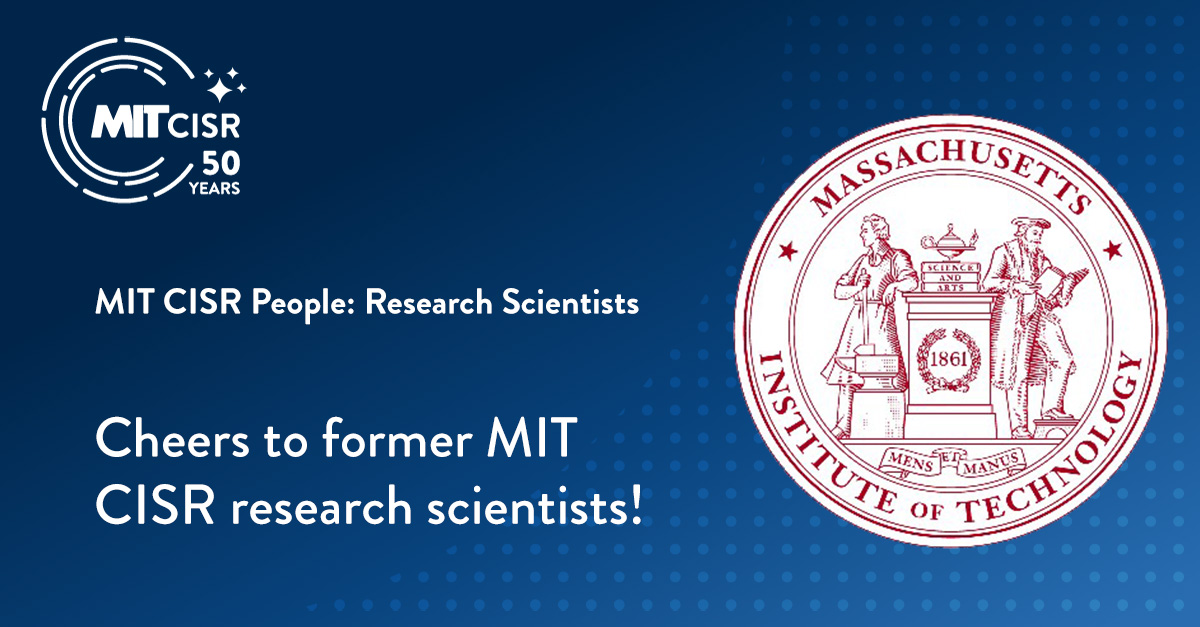
MIT’s motto, “Mens et manus” (mind and hand), which promotes the ideals of education and research for practical application, is reflected in MIT CISR’s mission: “MIT CISR helps executives meet the challenge of leading increasingly digital and data-driven organizations. Founded in 1974 and grounded in MIT’s tradition of combining academic knowledge and practical purpose, we work directly with digital leaders, executives, and boards to develop our insights.”
In its early days, MIT CISR research was focused on issues relevant to IT executives and was primarily conducted by a wide variety of IT faculty from MIT, the Boston area, and beyond, and was supported by research scientists. In the early 2000s, the mix changed with research scientists leading research projects (with faculty collaboration). MIT CISR thanks past research scientists for their work helping to make MIT CISR the research center it is today.
• Read about the MIT motto.
• See our list of our Consortium members.
#MITCISR50th #MITCISR
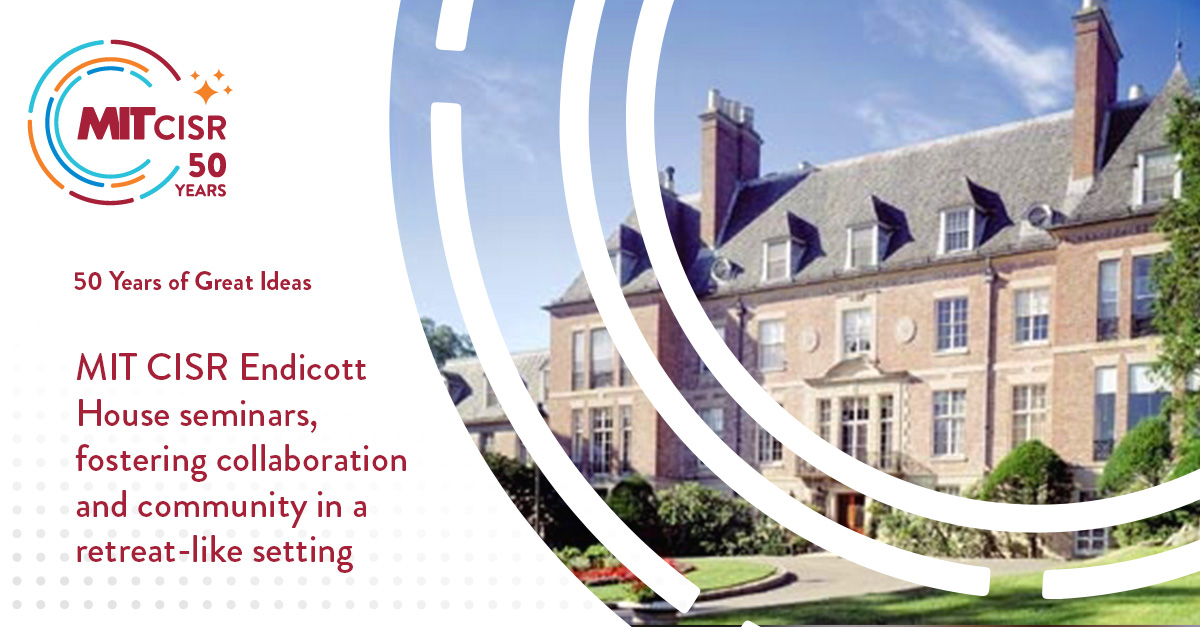
MIT CISR began a series of 2½-day seminars in March 1978, dubbed the “Endicott House Seminars” after the conference center where they were held, a former estate donated to MIT by the Endicott family in the 1950s. The seminars, held twice a year, played an important role in fostering collaboration between MIT CISR researchers and sponsor organizations. Each event focused on a specific IT management topic and featured short presentations by sponsors, MIT CISR researchers, outside experts, and much discussion. The gracious ambience of the mansion was perfect for frank and lively conversations—often late into the evening. The seminars became integral to generating ideas and insights for CISR research and gave root to the peer-to-peer learning during events and collegial relationships among members that have become a hallmark of MIT CISR.
#MITCISR50th #MITCISR
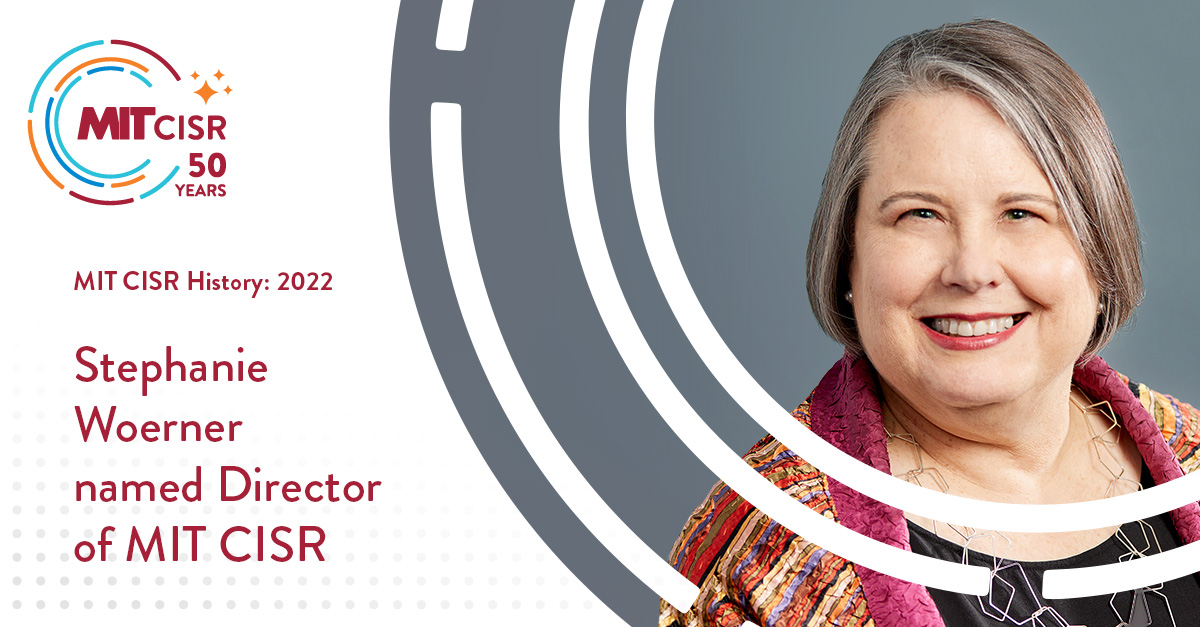
Stephanie Woerner became director of MIT CISR and MIT Principal Research Scientist in July 2022, and she is leading our transformation to MIT CISR 3.0. Stephanie joined MIT CISR in 2007, and she and Peter Weill have formed an enduring, productive research collaboration. They have coauthored two books and many articles in Sloan Management Review, Harvard Business Review and other publications, on topics like digital business models, pathways to Future Ready, and domains, among others.
Stephanie is passionate about understanding—through evidence-based research—how organizations create new business value from technology. She works to effectively communicate these and other research findings to MIT CISR members. She edits many of the 3-page research briefings (distributed to almost 23,000 business leaders monthly), helps authors synthesize the actionable items into the one-page Talking Points, and enjoys designing event and workshop agendas. Stephanie is also an in-demand presenter for senior executive teams.
Stephanie still loves to get her hands on a new data set and analyze it to help understand how top performing firms manage technology. Peter says, “Stephanie is the best data analyst I know. Her ability to tease out practical insights for business leaders from complex data is world class.”
• Learn more about CISR 3.0.
• Read about digital business models.
• Read about Future Ready.
• Read the SMR article.
• Read the HBR article.
• Read the MIT CISR publication on domains.
#MITCISR50th #MITCISR
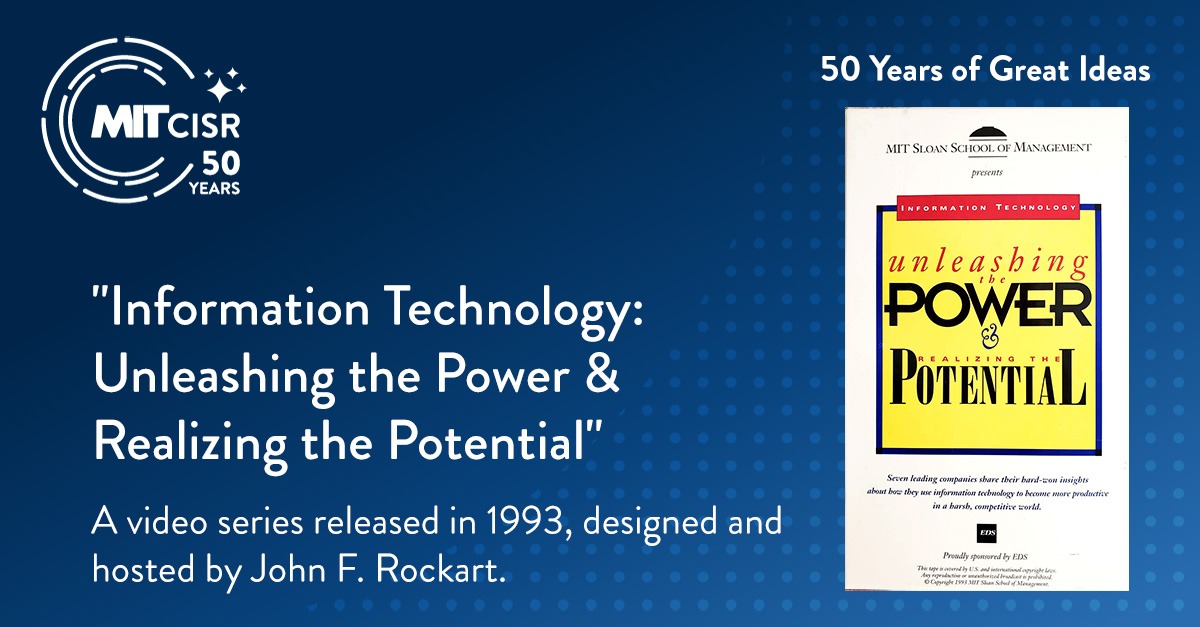
Produced by the MIT Sloan School, with sponsorship from EDS and distribution by the Forbes Initiative, the videotapes and accompanying Leader’s Guide were aimed at senior executives seeking guidance into how to realize the maximum return from their IT investments. The series featured first-hand success stories from CEOs and CIOs from seven major enterprises, including Johnson & Johnson, JCPenney, and Xerox, and insights from Sloan faculty, including Stuart Madnick, Thomas Malone, Peter Senge, and Lester Thurow.
#MITCISR50th #MITCISR
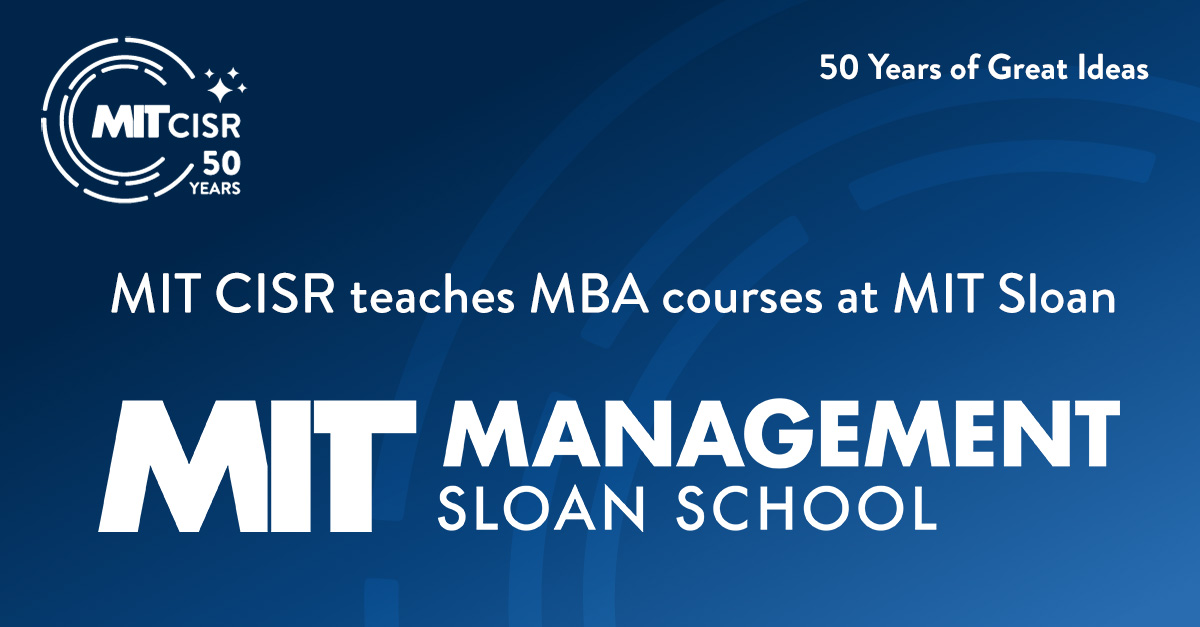
MIT CISR is affiliated with MIT Sloan School's IT Group and MIT CISR directors taught in the MIT Sloan MBA program from the mid-1970s until the 2017. Jack Rockart taught a popular MBA course, “Management of the IS Function” for many years. Peter Weill taught two MBA courses, “Generating Business Value from IT” and “e-Business Models,” a course based on his and Michael Vitale’s book, Place to Space: Migrating to e-Business Models, from 2000 to the early 2010s. He received the Sloan “Excellence in Teaching Award” for the 2006–2007 academic year. Jeanne Ross continued teaching a course based on MIT CISR research after Peter and then in 2015 transformed the course into an Action Learning program. “Enterprise Transformations in the Digital Economy (T-Lab)” used MIT CISR cases and brought in CIOs from MIT CISR sponsor companies to talk about digital business transformation. In addition, T-Lab successfully matched teams of Sloan students with MIT CISR member companies to work on a specific digital management issue the firms were attempting to address.
• Read about the MIT Sloan IT Group
• See more about the Place to Space book
• Read more about Action Learning at MIT Sloan
#MITCISR50th #MITCISR
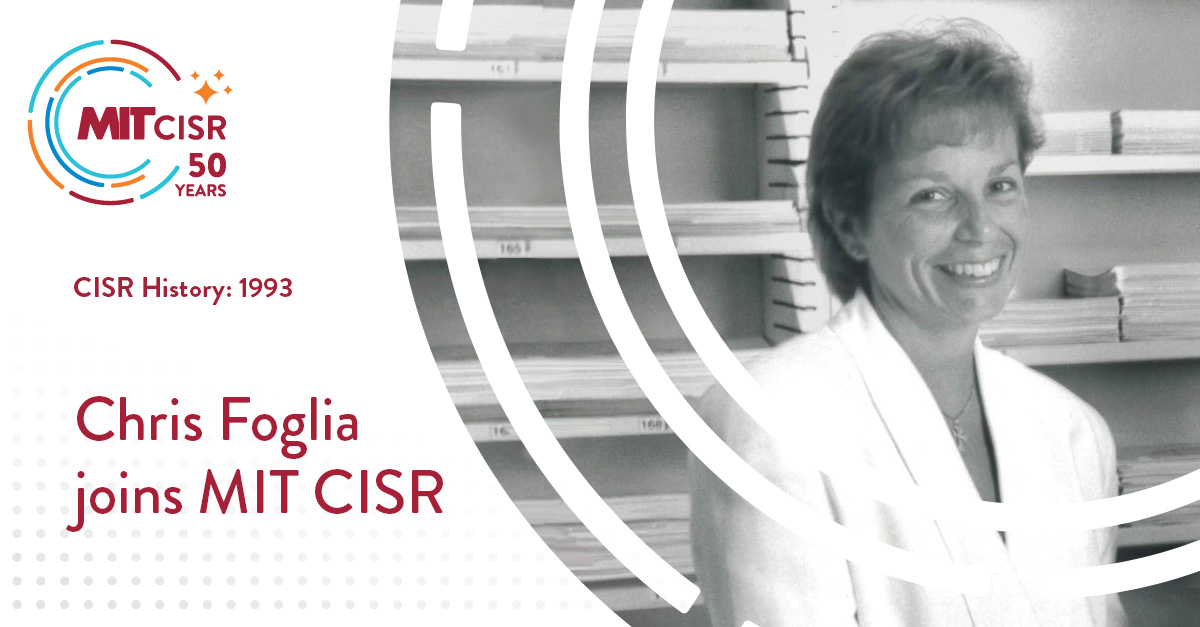
Chris Foglia joined MIT CISR in 1993, making her CISR's longest tenured employee. Every CISR member, guest, and researcher has been a beneficiary of Chris’s willingness to try new things and her insistence that CISR pursue excellence not only in research but in delivery.
Chris started her career at MIT at the Medical Department followed by seven years with the MIT Alumni Association, during which she learned her way around MIT. This was later proven useful, as MIT CISR sought both to contribute to MIT’s mission and to leverage the vast resources of MIT to serve our members. And, when Peter Weill announced his intentions to globalize CISR in 2000, Chris proved to be the perfect operating officer to bring his vision to fruition.
Chris was prescient about the need for quality data to run CISR. She has been zealous in maintaining CISR's records and in establishing systems and platforms to ensure that CISR operates like a well-oiled machine. CISR’s systems are the envy of many other research centers, and Chris and the administrative team are often asked to demo them for groups across campus. She has mastered the art of finding venues, food, and group activities in every global city that hosts a CISR event and Chris is THE person who ensures every sponsor is treated with respect and care, every researcher has the resources needed to run their projects, and every event runs as smoothly as possible. In 2008, in recognition of her extraordinary leadership and creativity, Chris was named Associate Director of MIT CISR. She continues to manage many of CISR's operations and to host extraordinary sponsor and team events. In fact, if Chris invites you to a celebration, be sure to attend—you won’t want to miss it.
#MITCISR50th #MITCISR
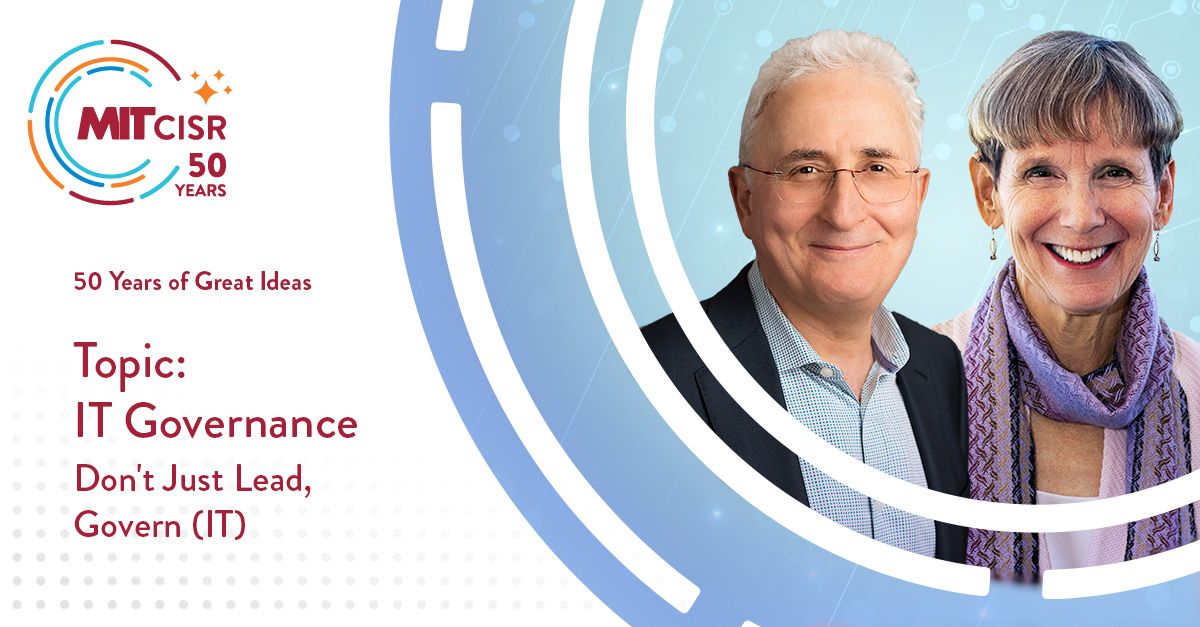
One research interest Peter Weill brought to MIT CISR was a passion for IT Governance. In Research Briefing Vol. 1, No. 2B, "Effective IT Governance," he and researcher Richard Woodham defined IT governance as the specification of decision rights and an accountability framework that encourages desirable behavior in the use of IT. The briefing laid out a set of business objectives, IT governance styles and business performance goals with accompanying behaviors, mechanisms and metrics. Peter and his collaborators found firms with superior IT governance had higher profits than firms with poor IT governance. In 2004, Peter and Jeanne Ross described the MIT CISR IT governance framework, the types of IT decisions and who should be involved in those decisions in their book, IT Governance, which has been influential in both academia (with over 3600 citations) and business. As IT (and now digital) decisions are of ever-increasing importance to enterprise performance, this research has continued to help enterprises get true value from their IT and digital investments.
• See more about the IT Governance book by Weill and Ross
• Read an MISQE article on this topic by Peter Weill
• Read an MIT Sloan Management Review article by Weill and Ross
#MITCISR50th #MITCISR #ITgovernance
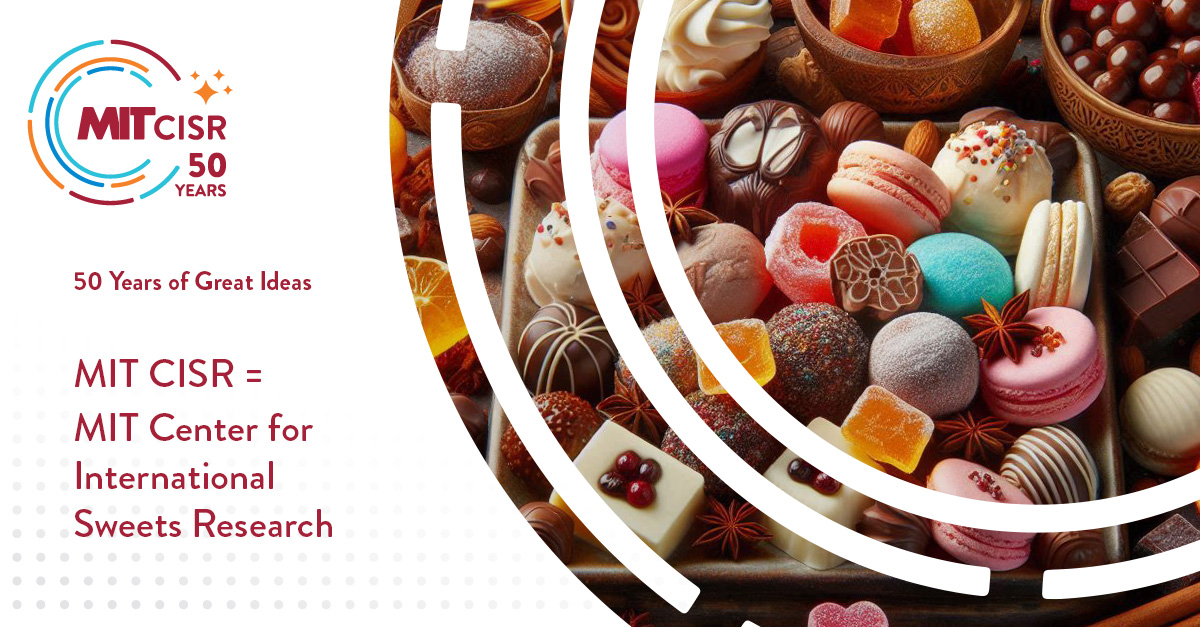
We aren't sure how long this fine tradition goes back, but it was well-established by the early 1990s, when there was even a ream of MIT CISR letterhead with the heading "Center for International Sweets Research." When the MIT CISR team travels, they bring back sweets—especially chocolate—to share at the office. Turkish delight, Brazilian brigadeiros, French macarons, Hawaiian macadamia nuts, Spanish nougat, Italian truffles, rice candies from Asia, and See's chocolates from San Francisco have all graced our snack board! Thank you to all of those who have shared goodies from across the globe.
#MITCISR50th #MITCISR
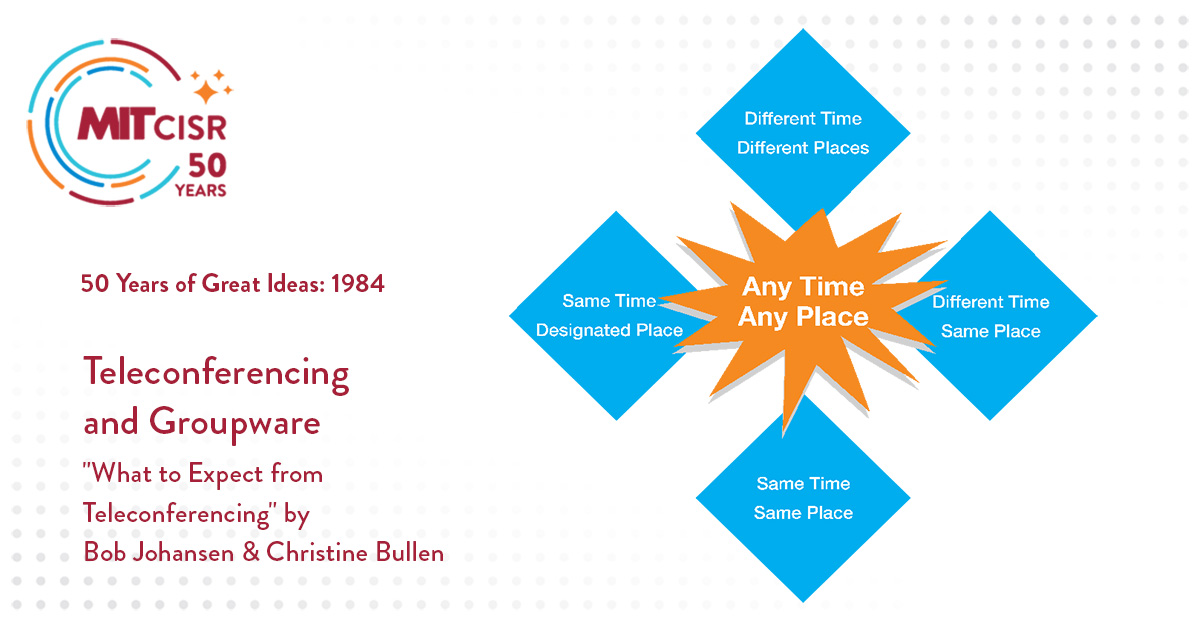
“What to Expect from Teleconferencing” by Bob Johansen and Christine Bullen was published in Harvard Business Review March-April 1984. This was one of the first articles written on the emerging technology of teleconferencing and explained the options available at that time as well as providing management guidelines for its effective use in organizations. The “rules of thumb” resulted from research that Bob and Christine carried out in a number of companies that were experimenting with it. Differentiating between “synchronous,” i.e., when all participants were present at the same time regardless of location and time zones, and “asynchronous,” i.e., when participants can check in when they wish, formed the basis of a 2x2 graphic that foreshadowed the technologies we use today.
#MITCISR50th #MITCISR

Leslie Owens joined MIT CISR as Executive Director and Senior Lecturer in 2015, after Jeanne Ross stepped aside as Director. Leslie brought a fresh outside view to MIT CISR and a keen editorial eye to the research. She encouraged the team to try new technologies and ways of working. Leslie has remained active with MIT CISR after leaving in 2021, coauthoring Data is Everbody’s Business with Barb Wixom and Cynthia (Dr. Boo) Beath in 2023.
See more about Data is Everybody's Business.
#MITCISR50th #MITCISR
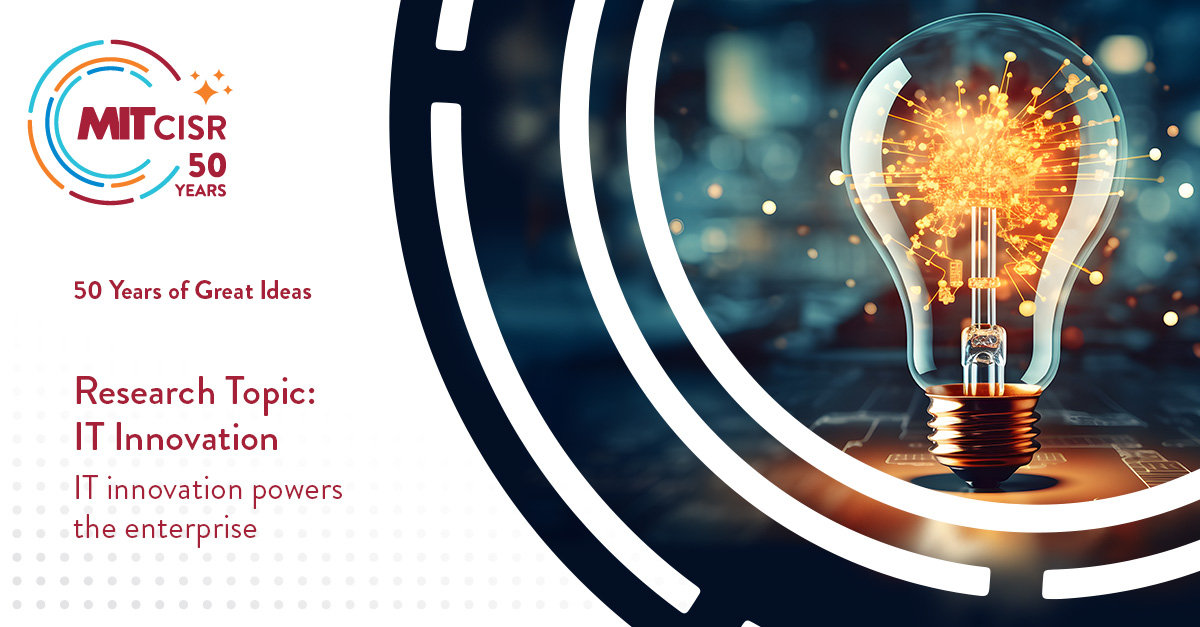
IT innovation is necessary for enterprise success, but it must be measured to ensure value and so MIT CISR's IT innovation research began with work focused on the IT portfolio. In their 1998 book Leveraging the New Infrastructure: How Market Leaders Capitalize on Information Technology, Peter Weill and Marianne Broadbent highlighted the importance of tracking investments in the IT portfolio including those for strategic (i.e., innovation) purposes. (The other three asset classes noted in the book were infrastructure, transactional, and informational.) Peter and his co-authors continued this stream of research through 2016, showing that becoming a more digital enterprise created a need for more infrastructure but that those infrastructure investments were correlated with more revenues from innovations.
Nils Fonstad's research in this area focused on the innovation portfolio, identifying four different types of innovation efforts enterprises need to engage in for long-term competitiveness: employee experience, customer facing, business operations, and new business models. He found that the allocation of the innovation portfolio mattered more to enterprise success than the total amount invested and that successful innovation involves learning across the enterprise. Peter and Stephanie Woerner have looked at how CIOs spend their time, especially around innovation (see The CIO as a Venture Capitalist). And more recently, Alan Thorogood examined the role of start-ups in helping large enterprises innovate.
• See more about the Leveraging the New Infrastructure book
• Read the 2016 Infrastructure briefing
• Review MIT CISR research on digital innovation
Read these digital innovation and IT portfolio-related briefings:
• Designing a Competitive Innovation Portfolio
• Becoming a Serial Innovator of Digital Offerings
• Three Imperatives to Learn From Your Digital Innovation Initiatives
• Top-Performing CIOs in the Digital Era
• The CIO as a Venture Capitalist
• Going Faster is Not Enough; Add Innovation to Outperform
• How Tech Leaders of Top-Performing Companies Spend Their Time
• xTechs Innovation: Achieving Speed While Managing Risks
#MITCISR50th #MITCISR #Innovation
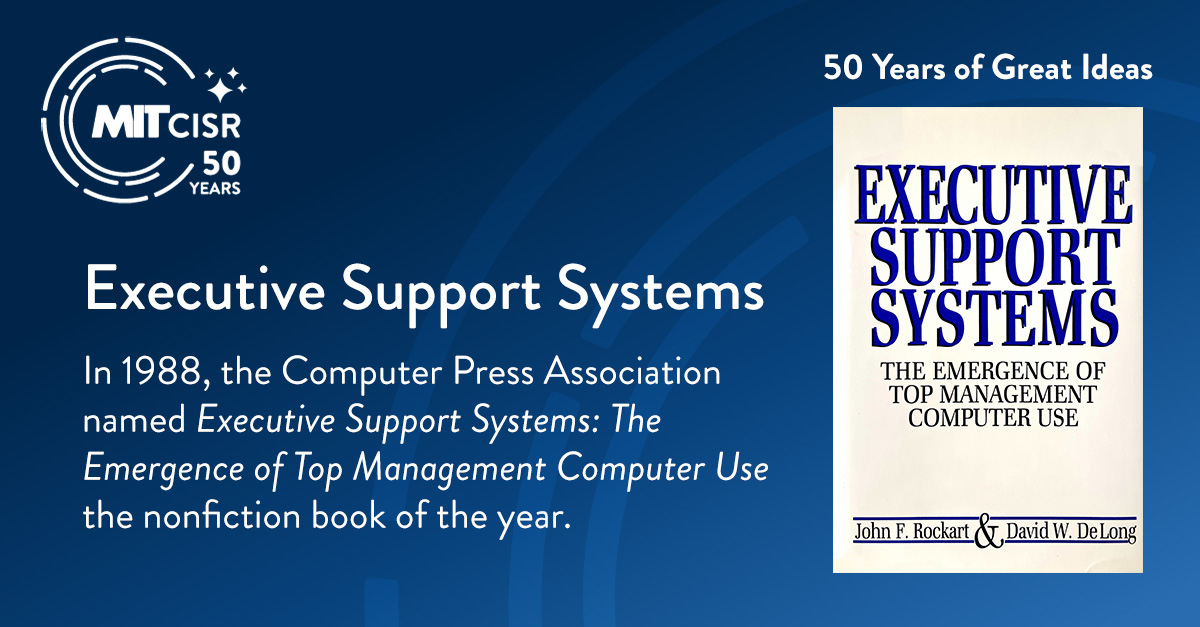
Written by John F. Rockart and David W. De Long, the book built on concepts from decision support systems to develop approaches for meeting the particular information needs and circumstances of CEOs and other top executives in an era when a computer terminal or PC was a very rare sight in executive offices.
Borrow the book online.
#MITCISR50th #MITCISR

Established in 2015, MIT CISR Data Research Advisory Board is composed of data and analytics leaders who engage in academic research and directly shape research insights. Drawn from CISR organizations, these leaders tirelessly help CISR researchers by participating in surveys, interviews and case studies; contributing to quarterly conversations about contemporary topics like Gen AI, cross-company data sharing and acceptable data use; attending virtual and in-person meetups, webinars and events; and embracing new ways to influence the field in positive ways. For example, in 2018, the Data Board co-authored an article about creating and implementing an effective data strategy, and most recently the Data Board contributed to the MIT CISR book Data is Everybody’s Business: Foundations of Data Monetization (MIT Press 2023) by writing the foreword, providing quotes, and serving as examples. To date, 340 different leaders at 167 distinct companies from around the world have served on the Data Board. The researchers, especially board founder and advisor Barb Wixom, are grateful for every one of these committed thought leaders.
• Learn more about the MIT CISR Data Research Advisory Board.
• Read the Data Board's data strategy article.
• Read more about Data is Everybody's Business.
#MITCISR50th #CISRDataBoard #LifeLongLearners #DataMonetization #MITCISR
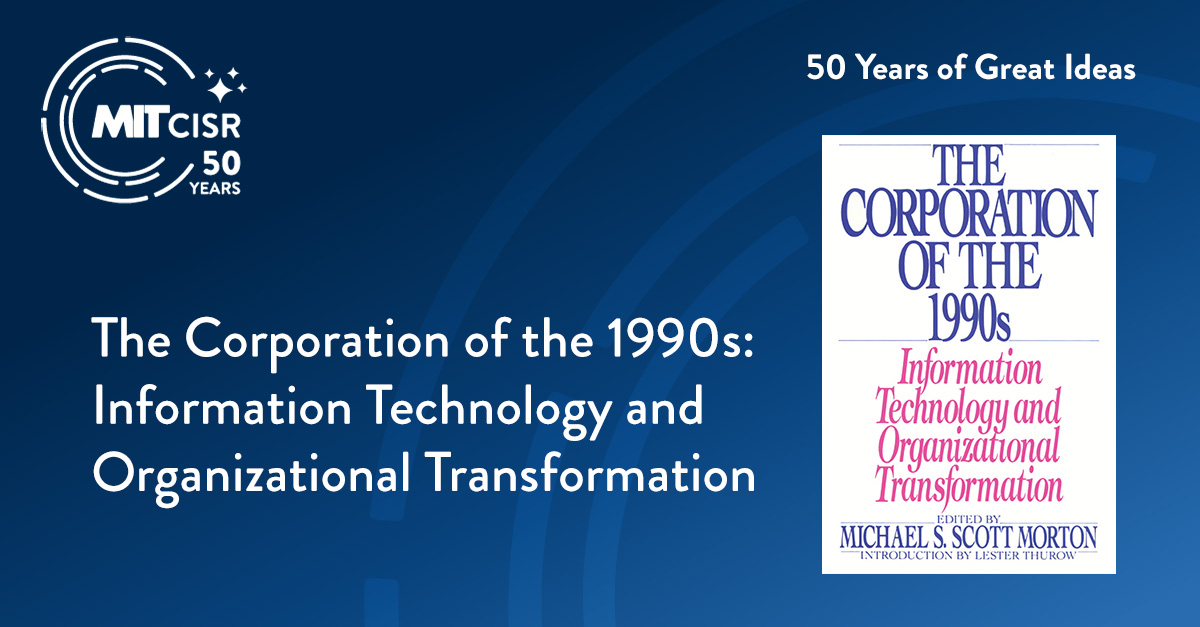
This book (Oxford University Press, 1991) was the culmination of an ambitious research program launched by MIT Sloan in 1984 to investigate how advances in information technology would affect the way organizations would be able to survive and thrive in the 1990s and beyond. The program, led by Prof. Michael Scott Morton, was a close collaboration of researchers from multiple Sloan departments, including MIT CISR, and business executives from a diverse set of industries and the public sector.
• Borrow the book.
• Learn more about Michael Scott Morton.
#MITCISR50th #MITCISR
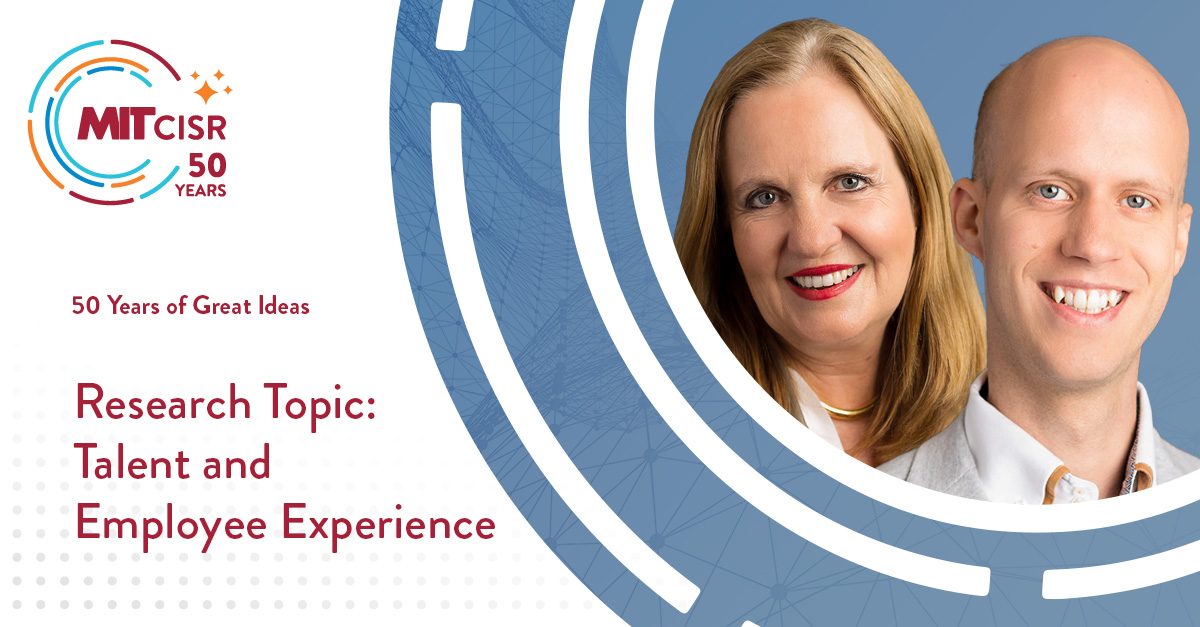
“It’s all about the people” has been a recurring phrase at MIT CISR since 2014, when Kristine Dery joined the team as a research scientist. A year later, Nick van der Meulen collaborated with Kristine to study digital workplace design during an academic visit to MIT, laying the groundwork for follow-up research. By the time Nick became an MIT CISR research scientist in 2017, their focus had evolved into a comprehensive study of employee experience—examining how organizations might best enable their employees to do their jobs today, as well as reimagine their jobs of tomorrow. Central to their findings are organizational capabilities that create (1) adaptive work environments that meet changing employee needs, and (2) collective work habits that allow employees to express their ideas, experiment, and be empowered to improve work. Their research showed that investments in these employee experience capabilities lead to greater customer satisfaction, increased innovation, and higher profitability. Today, MIT CISR’s commitment to employee-focused research is ongoing: Nick has recently expanded the research to examine capabilities for employee skill development, and he is currently examining the impact of (generative) AI on the employee experience.
• Hear from Nick about MIT CISR employee experience research.
• Learn more about this year's project on AI at Work.
• View the collection of MIT CISR's research on employee experience.
• Read a recent research briefing on Talent.
• Read about the Future Ready Workforce.
#MITCISR50th #MITCISR #EmployeeExperience
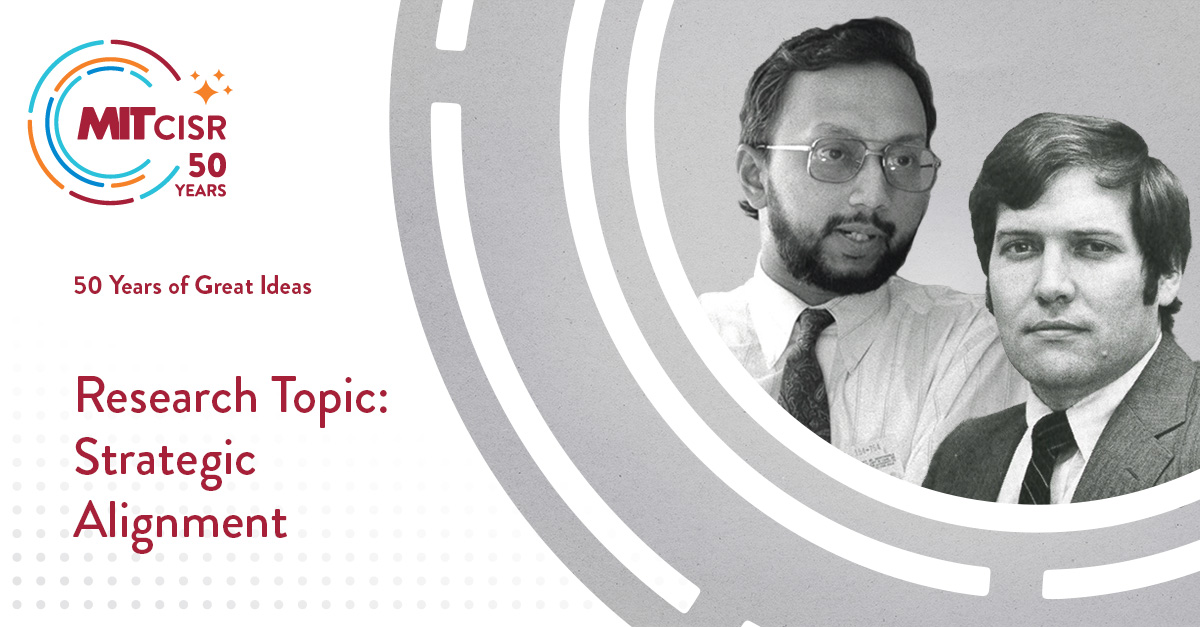
John Henderson and N. Venkatraman published the first version of their Strategic Alignment Model in 1989 in MIT CISR Working Paper 219. The model presented four domains—business strategy, information technology strategy, organizational infrastructure and processes, and information systems infrastructure and processes—which must align for an organization to achieve its goals. The model examined two characteristics of strategic management: strategic fit between the organization and the external environment and integration between the business and functional domains. The model has been cited over 7500 times in academic literature.
• Download MIT CISR Working Paper No. 219
• Learn more about John Henderson
• Learn more about Venkat Venkatraman
#MITCISR50th #MITCISR
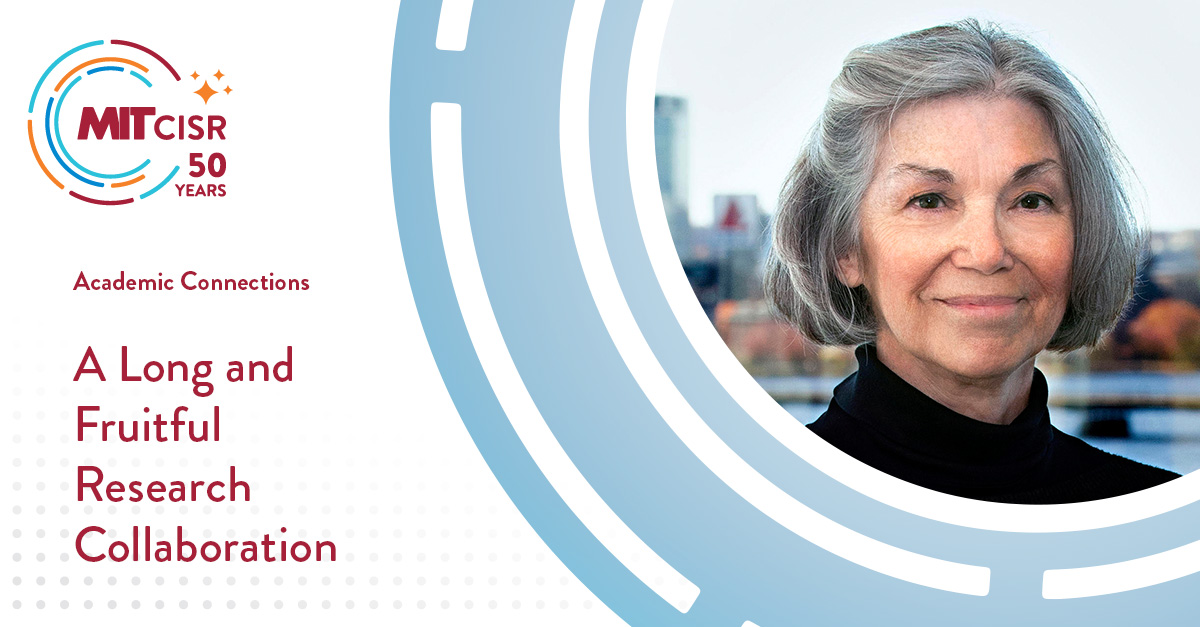
MIT CISR researchers have collaborated with outside researchers and practioners since the inception of CISR and Dr. Cynthia Beath is probably our longest-running collaborator. She has been a valued MIT CISR research team member, publishing her first MIT CISR Working Paper, "Generating Value from Infrastructure Investments: An Examination of Client-server and Teams," in 1995 and her first Sloan Management Review article “Develop Long-Term Competitiveness through IT Assets” published in 1996. Initially, Cynthia worked with the MIT CISR team while serving as Full Professor at the University of Texas at Austin; since her faculty retirement in 2004, Cynthia has become a valued team member at MIT CISR and has made a dizzying number of contributions while serving as co-author, researcher, mentor, advisor, innovator, editor, champion and cheerleader. Cynthia, known by her colleagues as Dr. Boo, is a prodigious, provocative and prolific writer; to date, she has co-authored 100 MIT CISR articles, including “Beyond the Business Case,” “Why You—Yes You—Need Enterprise Architecture,” "Digitized ≠ Digital,” and “AI is Everybody’s Business.” She also co-authored two books with CISR researchers. Cynthia is an extraordinary interviewer, a thorough and thoughtful reviewer, a patient listener, and a much beloved colleague, who deserves much credit for MIT CISR’s impact on management practice.
• Download MIT CISR Working paper 269.
• Purchase the Sloan Management Review article.
• See more about Designed for Digital.
• See more about Data is Everybody's Business.
#D4D #DataMonetization #MITCISR50th #MITCISR
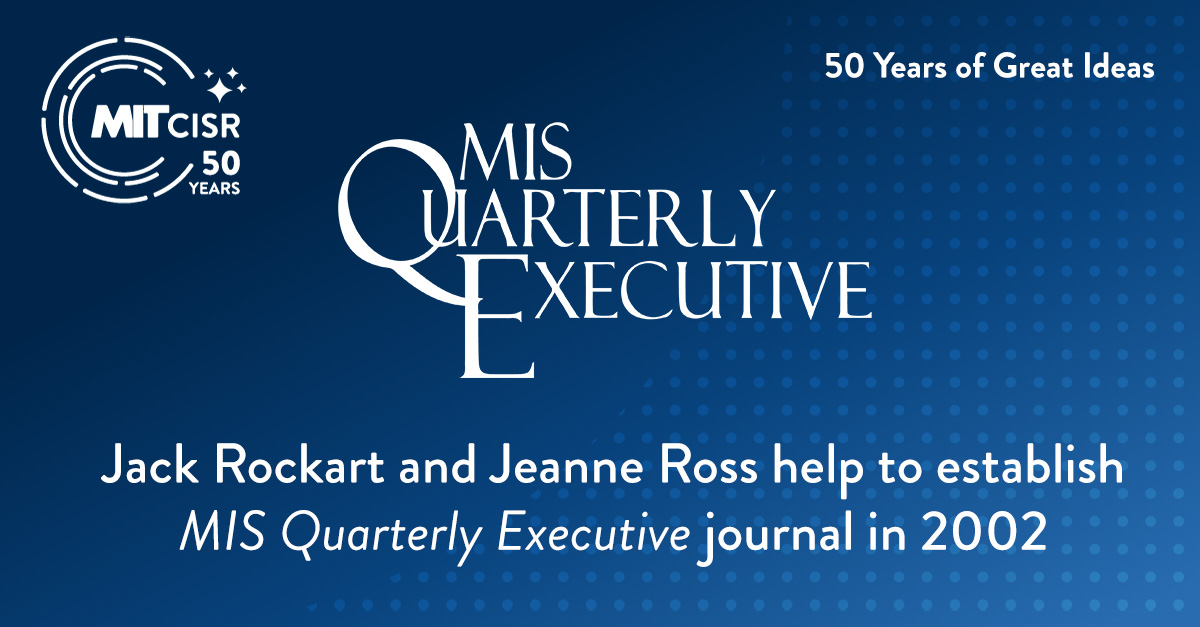
Following the removal of the Application section of MISQ, practice-based research did not have a clear home until Allen Lee and a team of leading academics established the MIS Quarterly Executive journal in 2002. An official sister publication of MIS Quarterly, MISQE has been led by several editors-in-chief who are well known in our discipline as scholars dedicated to industry-relevant research—including Jack Rockart (the first editor-in-chief) and Jeanne Ross from MIT CISR and Carol Brown, Dorothy Leidner, Gabe Piccoli, all of whom have been visiting scholars at MIT CISR.
• Visit the MISQE home page.
• Read more about Jack Rockart.
• Read an editorial about the history of MISQE.
#MITCISR50th #MITCISR #MISQE
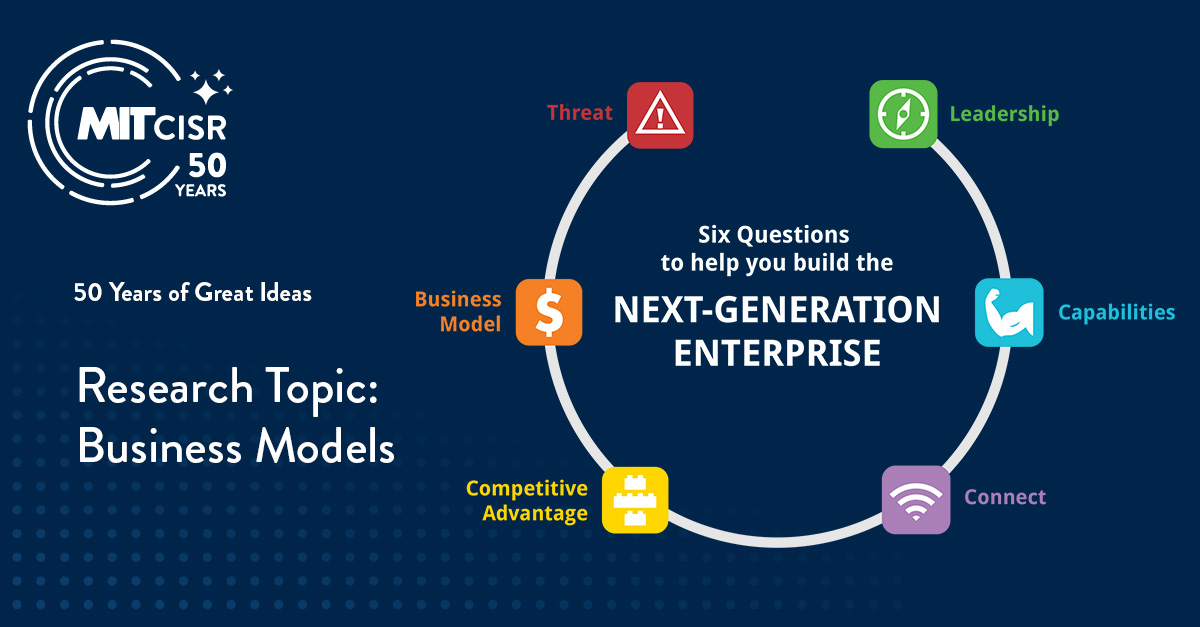
At the same time that digital technologies began to disrupt companies, MIT CISR research began to reach a wider audience as executives looked for guidance on how to leverage those same technologies. It was clear that in the new digital economy, many companies wouldn't succeed by merely tweaking their management practices—they would have to substantially change the way they did business. Peter Weill and Stephanie Woerner began their business model research to learn about digital disruption and how companies were transforming themselves to address those disruptions. The research started with a series of focus groups with CIOs, asking them to describe their most important IT-enabled business transformations (resulting in a collection of 144 project descriptions). Two dimensions arose out of the analysis of the projects: 1) learning more about customers, and 2) changing business design. These two dimensions became the basis of the business model framework. That framework with its four business models, Supplier, Omni-channel, Modular Producer, and Ecosystem Driver, offered companies a systematic way to think about how they would make money in the digital economy and the changes they had to make to change their business model. Peter and Stephanie administered surveys, conducted interviews and did workshops with over 1000 organizations and in 2018 published What's Your Digital Business Model? Six Questions to Help You Build the Next-Generation Enterprise.
• Read more about this topic.
• See more about Peter and Stephanie's business models book.
• Read this research briefing Six Questions to Help You Build the Next-Generation Enterprise.
#MITCISR50th #MITCISR #DigitalBusinessModels

In 2000, Wanda Orlikowski (Principal Investigator), Peter Weill (Co-PI), Erik Brynjolfsson (Co-PI), JoAnne Yates (Co-PI), and Thomas Malone (Co-PI) won a five-year National Science Foundation grant to study how large companies were using the internet. MIT Sloan research centers CISR, IDE (Initiative on the Digital Economy), and CCI (Center for Collective Intelligence) coordinated the grant activities and Stephanie Woerner began her career at MIT as project manager for the overall grant as well as participating in the on-going research projects the grant supported. Research focused on three areas: organizational design and performance, organizing practices, and business models. The research projects used multiple theoretical and methodological approaches and generated over 25 publications as well as nine MIT CISR research briefings. Over its lifetime, the grant supported two post-docs, 19 doctoral students including Sinan Aral, Nils Fonstad, Kate Kellogg, and Melissa Mazmanian, seven master’s students, and 21 undergraduate students.
• See more about the grant award.
• Learn more about Wanda Orlikowski.
• Learn more about Peter Weill.
• Learn more about Erik Brynjolfsson.
• Learn more about JoAnne Yates.
• Learn more about Thomas Malone.
• Learn more about MIT CISR.
• Learn more about MIT IDE.
• Learn more about MIT CCI.
• Learn more about Stephanie Woerner.
• Learn more about Sinan Aral.
• Learn more about Nils Fonstad.
• Learn more about Kate Kellogg.
• Learn more about Melissa Mazmanian.
#MITCISR50th #MITCISR
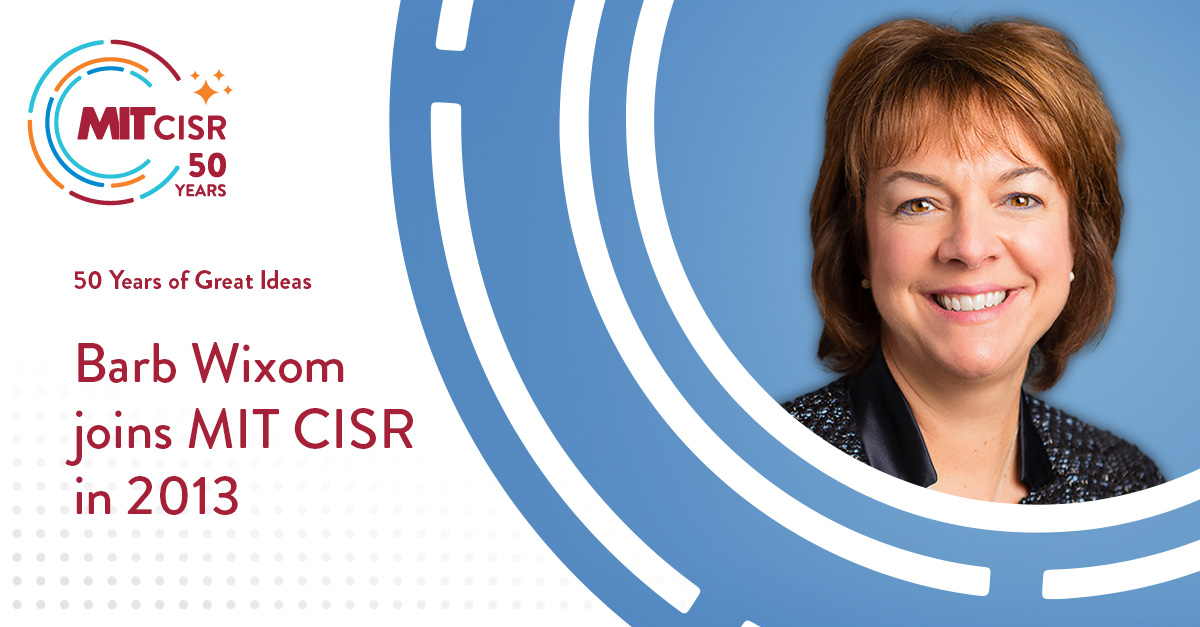
Barb Wixom first came to MIT CISR in 2012 as a visiting scholar and a year later, joined the team as a principal research scientist to lead MIT CISR's data research stream. Over the past decade, Barb has surveyed thousands of executives, conducted more than thirty case studies, and collaborated with more than twenty researchers from universities around the globe to shed light on emergent data issues and opportunities. She clarified terms like “data monetization,” introduced terms like “data wrapping” and “data liquidity” to inspire contemporary thinking, and established a global network of highly-engaged data leaders who regularly inform her research. In the fall of 2023, Barb published Data is Everybody’s Business: Foundations of Data Monetization, co-authored by Cynthia Beath (aka Dr. Boo) and Leslie Owens. The book distills Barb's 30-plus years of research into a set of core frameworks and a common language that can help every organization make the most of their data.
• Learn more about Barb Wixom.
• Learn more about Dr. Boo.
• Learn more about Leslie Owens.
• Review MIT CISR data research.
• Read more about Data is Everybody's Business.
#MITCISR50th #MITCISR #datamonetization #datawrapping #dataliquidity
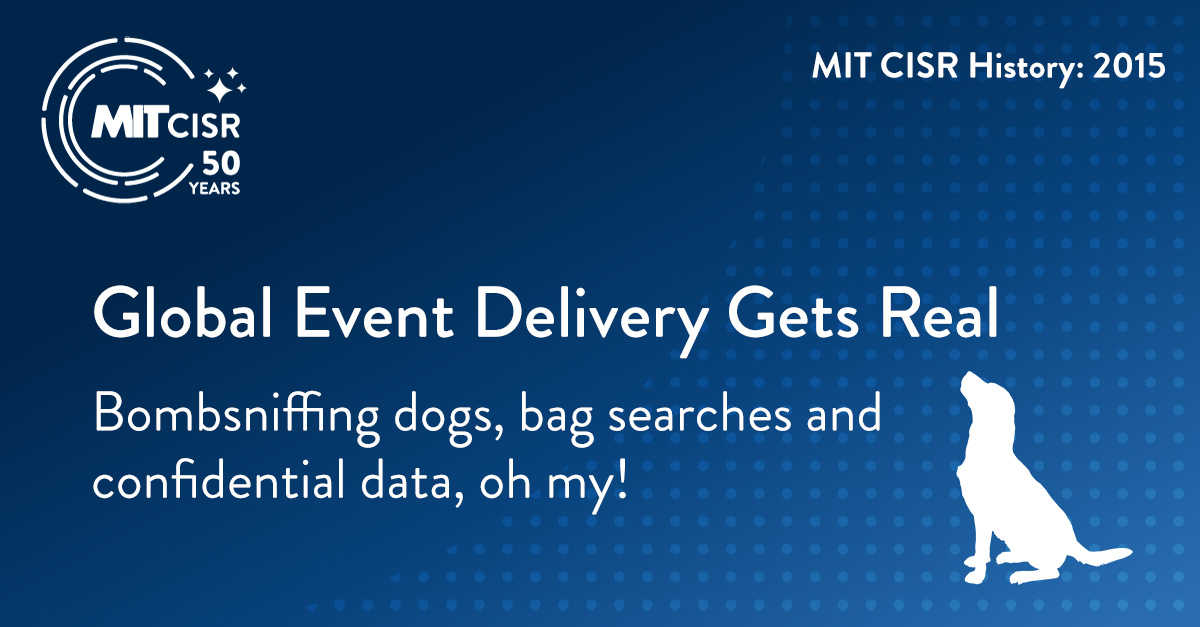
Just days before the 2015 European International Executive Forum in Warsaw, Poland, the MIT CISR event team was informed that a high profile political visitor would be in the venue during the event and Orange Polska (the event host) required the names, national identity numbers, dates of birth, and fathers' names for all event attendees. In just two days, this information was collected and provided just under the deadline. Day 1 of the event was uneventful, but Day 2 started with a first: a security check including bag searches and bomb sniffing dogs. Thankfully, both the MIT CISR event and the high profile visit went off without a hitch, a bang, or a bite.
Review recent MIT CISR Past Events including links to event-related content.
#MITCISR50th #MITCISR
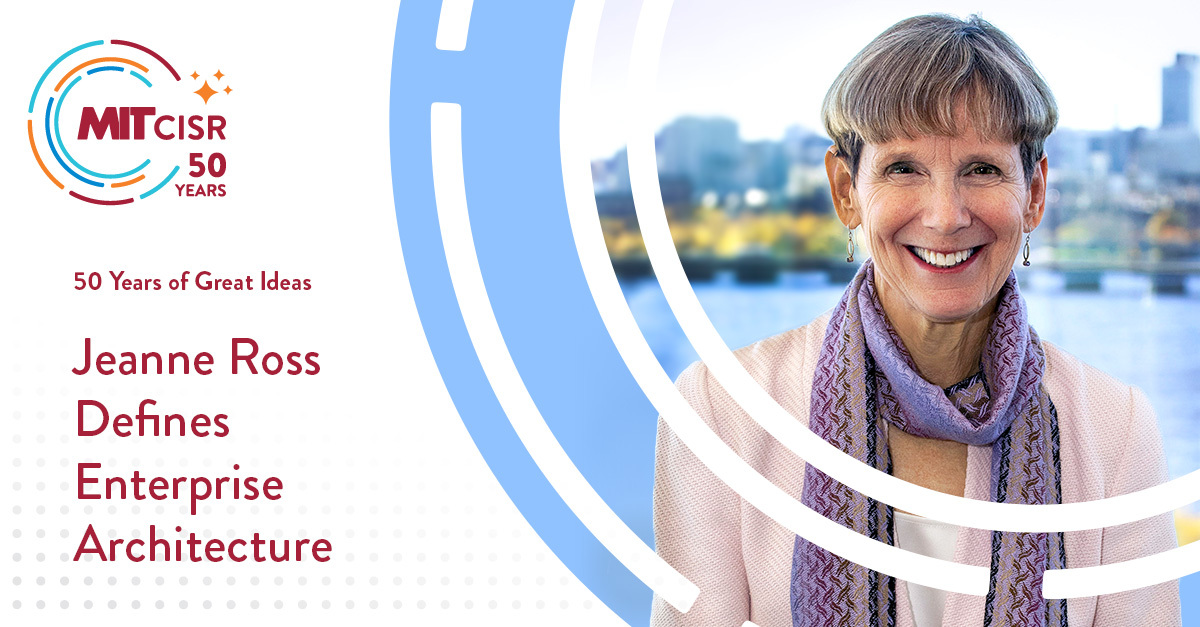
Jeanne Ross spent 30 years studying Enterprise Architecture (EA), the organizing logic for business processes and IT infrastructure. Drawing from over 50 case studies, Jeanne originated the 4-stage EA Maturity Model, describing the stages of EA that companies went through typically starting in business silos, moving to standardized technology, to an optimized core, and eventually business modularity. As they moved through the stages, companies got more and more strategic value from their technology. Jeanne, with co-authors Peter Weill and David Robertson, wrote Enterprise Architecture as Strategy: Creating a Foundation for Business Execution in 2006 and her 2004 MIT CISR research briefing, "Maturity Matters: How Firms Generate Value from Enterprise Architecture," remains one of the most downloaded research briefings available on the MIT CISR website. Jeanne continued to study EA throughout her career at MIT CISR, expanding and articulating the framework as digital technologies like social, mobile, analytics, cloud, the Internet of Things, and artificial intelligence were adopted and used by companies. Eventually she added a fifth stage, participating in a digital ecosystem, to the EA Maturity Stages. Jeanne's EA work culminated with the book Designed for Digital: How to Architect Your Business for Sustained Success, published in 2021 with co-authors Cynthia Beath and Martin Mocker. In that book, the authors described the five key building blocks of the modern company's digital architecture.
- See an overview of MIT CISR Enterprise Architecture Research.
- Read this article on MIT Sloan's Ideas Made to Matter about Jeanne's EA research.
- Read "Maturity Matters: How Firms Generate Value from Enterprise Architecture."
- Read "Five Building Blocks of Digital Transformation."
- See more about Enterprise Architecture as Strategy: Creating a Foundation for Business Execution by Jeanne W. Ross, Peter Weill, and David C. Robertson.
- See more about Designed for Digital: How to Architect Your Business for Sustained Success by Jeanne W. Ross, Cynthia M. Beath and Martin Mocker.
#MITCISR50th #MITCISR #EnterpriseArchitecture
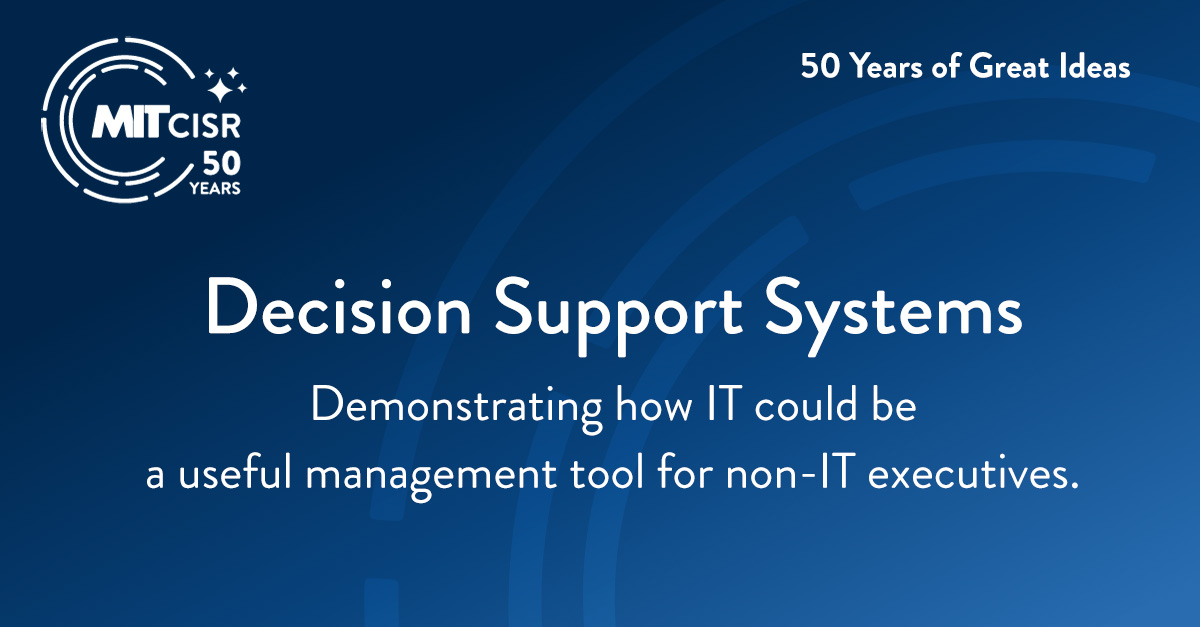
Decision Support Systems research demonstrated how information technology could be a useful tool for non-technical executives and laid the path for Executive Support Systems for higher-level executives. Prior to the introduction of Decision Support Systems, IT was seen by managers only as an accounting or operational tool. This research led to the book authored by Peter G.W. Keen and Michael S. Scott Morton in 1978, Decision Support Systems: An Organizational Perspective.
• Read the MIT CISR Working Paper No. 54.
• Learn more about Peter Keen.
• Learn more about Michael Scott Morton.
#MITCISR50th #MITCISR #DecisionSupportSystems
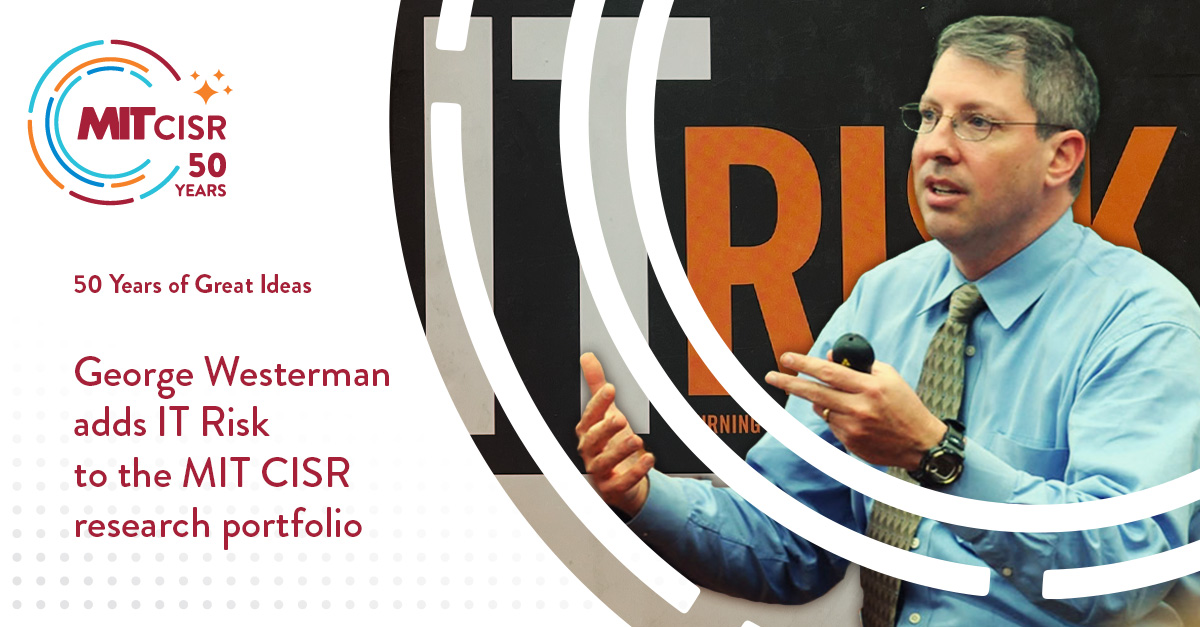
IT risk was understudied when George Westerman, a research scientist at MIT CISR from 2002 to 2011, began research on the dimensions of IT risk and how to communicate about it. In his book, IT Risk: Turning Business Threats into Competitive Advantage, written with Richard Hunter, George argued that incorporating IT risk into management conversations was a way to align IT and business objectives. During his time at MIT CISR, George also studied IT innovation and communicating the business value of IT. The latter topic was the subject of his book, also written with Richard Hunter, The Real Business of IT: How CIOs Create and Communicate Value.
• Read more about The Real Business of IT: How CIOs Create and Communicate Value.
• Read more about IT Risk: Turning Business Threats into Competitive Advantage.
• View a list of MIT CISR publications written by George Westerman.
#MITCISR50th #MITCISR #ITRisk
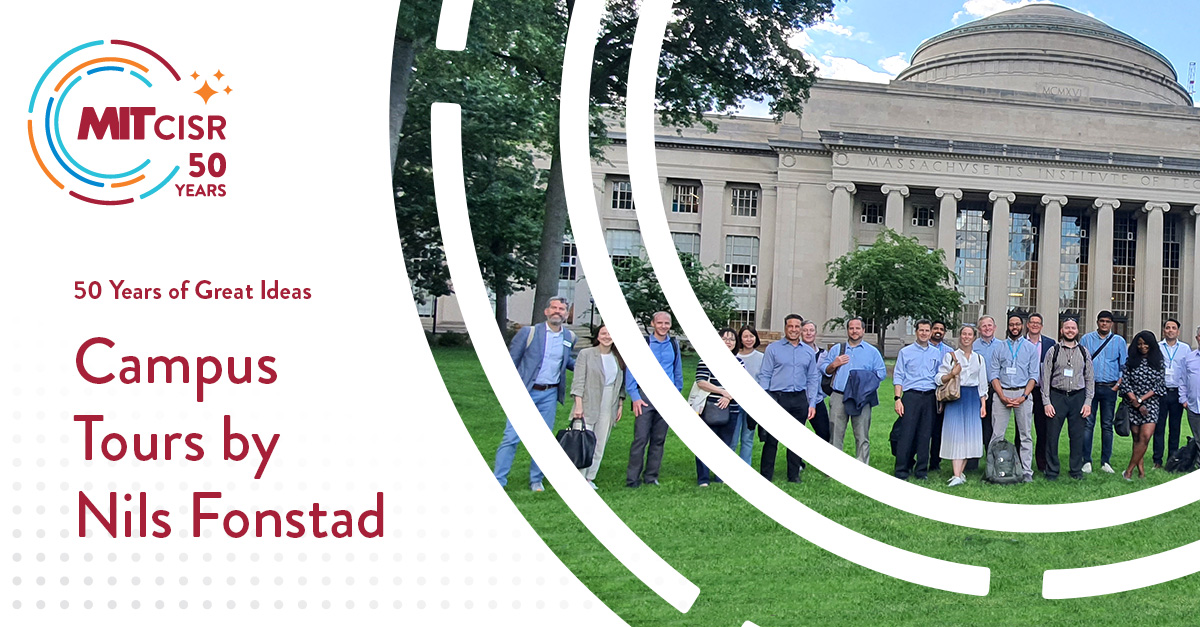
Many attendees of MIT CISR on-campus events over the past eight years undoubtedly cherish memories of campus tours led by the charming Nils Fonstad, former research scientist and current academic research fellow at MIT CISR. Nils, who spent his formative years on the MIT campus (his father is currently an MIT professor emeritus), has enthusiastically shared his favorite spots and captivating stories with many groups of MIT CISR event participants. Nils's infectious good nature has often inspired other campus wanderers to join the tour!
Learn more about Nils Fonstad.
#MITCISR50th #MITCISR
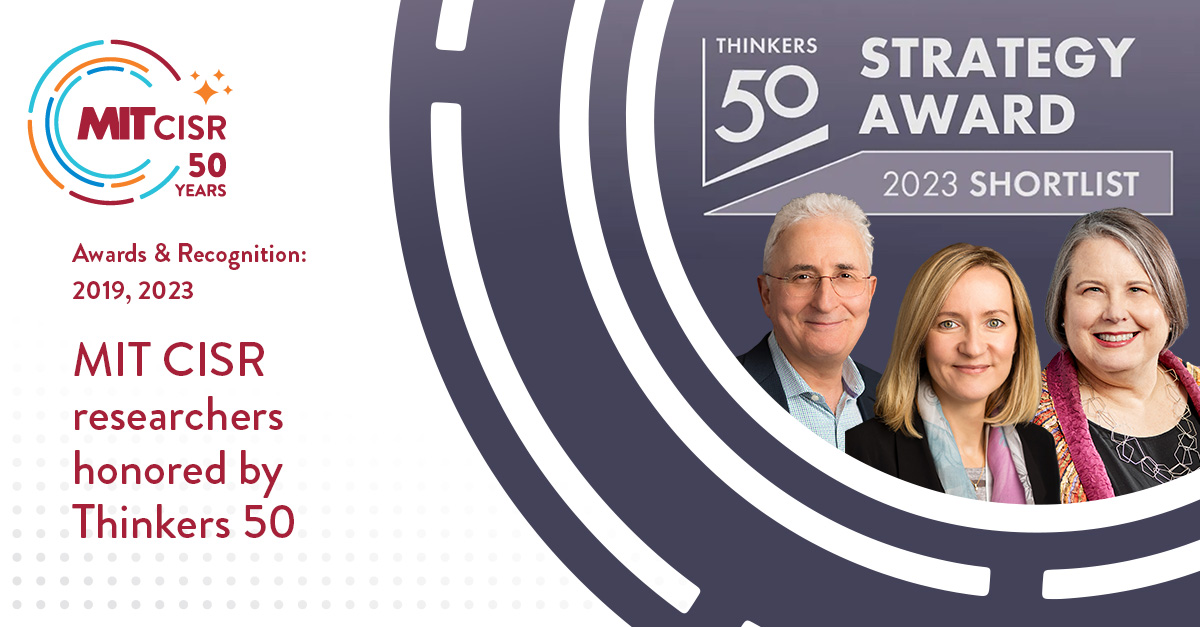
Thinkers50 honored Jeanne Ross as a finalist in 2019 for the Digital Thinking award for her research about how companies can retool for digital success. And in 2023, Stephanie Woerner, Peter Weill, and Ina Sebastian were finalists for the Thinkers50 Strategy award for their work on the different ways businesses undertake transformation and the types of organizational disruption that are necessary for change.
• Learn more about Jeanne Ross.
• Learn more about Peter Weill.
• Learn more about Stephanie Woerner.
• Learn more about Ina Sebastian.
Additional information on Thinkers50.
View the Thinkers50 2023 Strategy Award Shortlist.
#MITCISR50th #MITCISR #Thinkers50
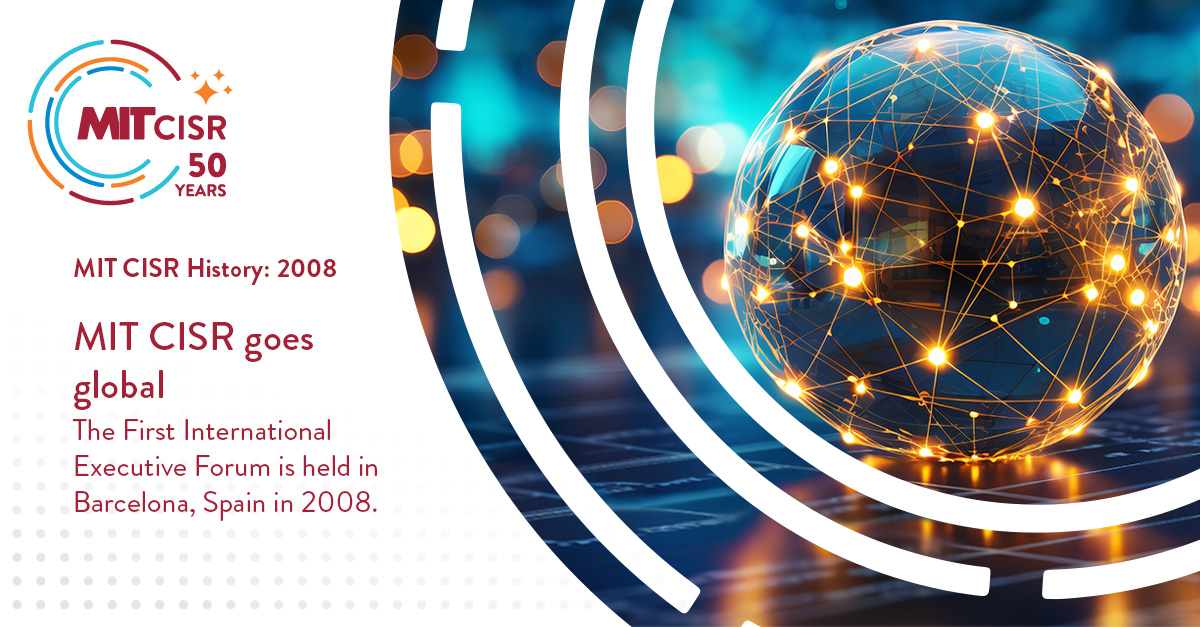
MIT CISR’s early attempts at globalization—with joint goals of global research supported by a global community of member organizations—began in 2008. The MIT CISR team produced the first of many subsequent international executive forums in April that year, co-hosted by IESE in Barcelona, Spain. In Sept. 2009, the “road show” moved to Sao Paolo, Brazil followed by forums in Copenhagen, Denmark and Sydney, Australia in the fall of 2010. MIT CISR currently holds international executive forums in Europe and Australia each year to maintain personal contact with members based in those regions, most recently in Sydney, Australia and Paris, France in March 2024. Our current global consortium includes organizations from Europe, Africa, Asia, Australia, and North, South, and Central America.
Review the list of current MIT CISR member organizations.
See a list of our past MIT CISR events.
#MITCISR50th #MITCISR
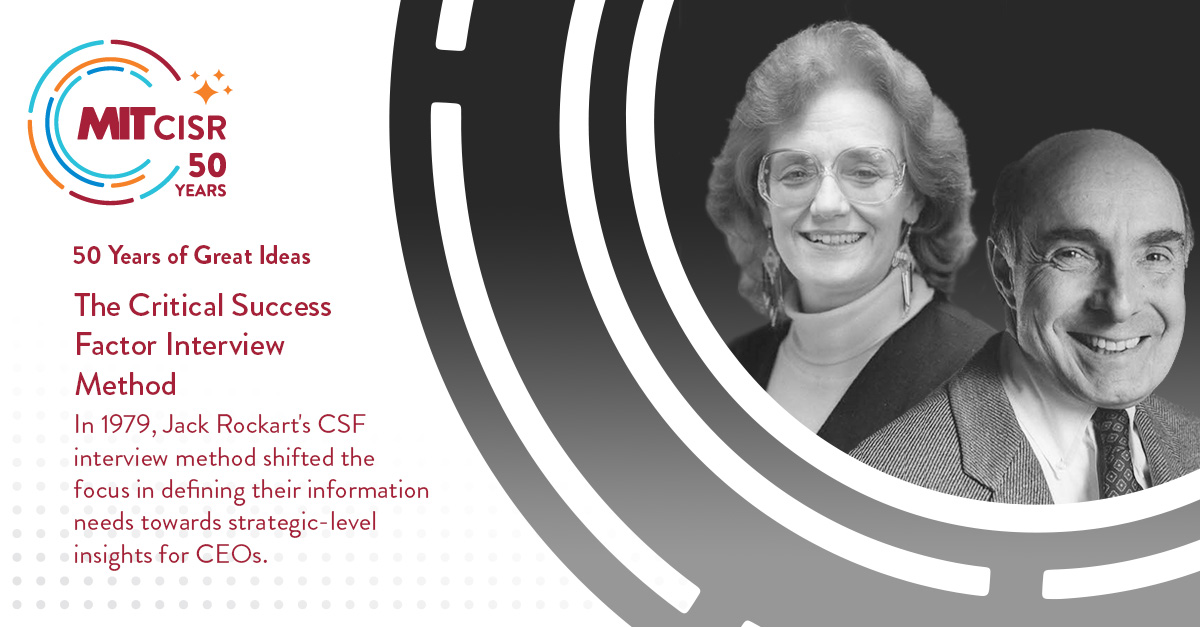
Jack Rockart and Christine Bullen used the concept of Critical Success Factors to design a method for talking with CEO-level executives about defining their information needs. At the time (1979) CEOs were receiving too much operational-level data, when what they needed was strategic managerial-level information. The CSF interview allowed CEOs to communicate their needs to their IT managers in a clear, never-before understood way.
- Read MIT CISR Working Paper No. 69, "A Primer on Critical Success Factors".
- Learn more about Jack Rockart on Wikipedia.
- Learn more about Christine Bullen at the Institute for the Future.
#MITCISR50th #MITCISR #research #CSFs #criticalsuccessfactors
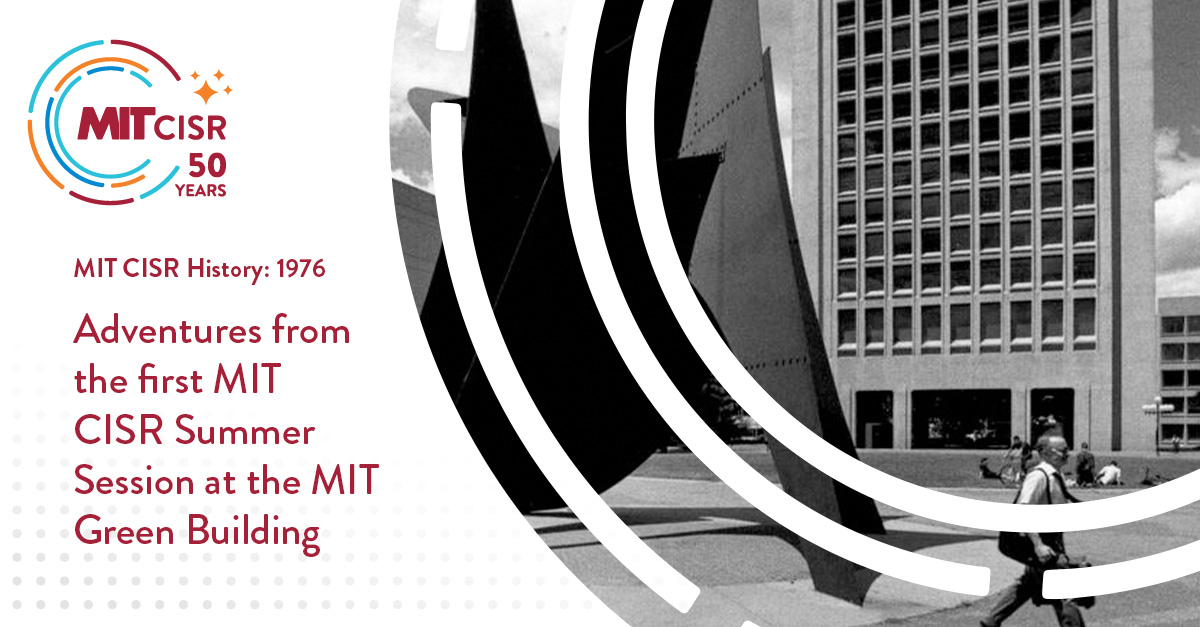
When Summer Session was held in the Green Building in the middle of the MIT campus, MIT CISR took advantage of the design of the building—featuring a pedestrian “underpass”—to set up refreshments for a pleasant outdoor break. It was quickly discovered that students passing by were confident that the refreshments were for them and “guards” were required to keep everything from disappearing. This was a very challenging assignment, as MIT students were (and still are!) wily and fast.
Additional info on the Green Building.
#MITCISR50th #MITCISR
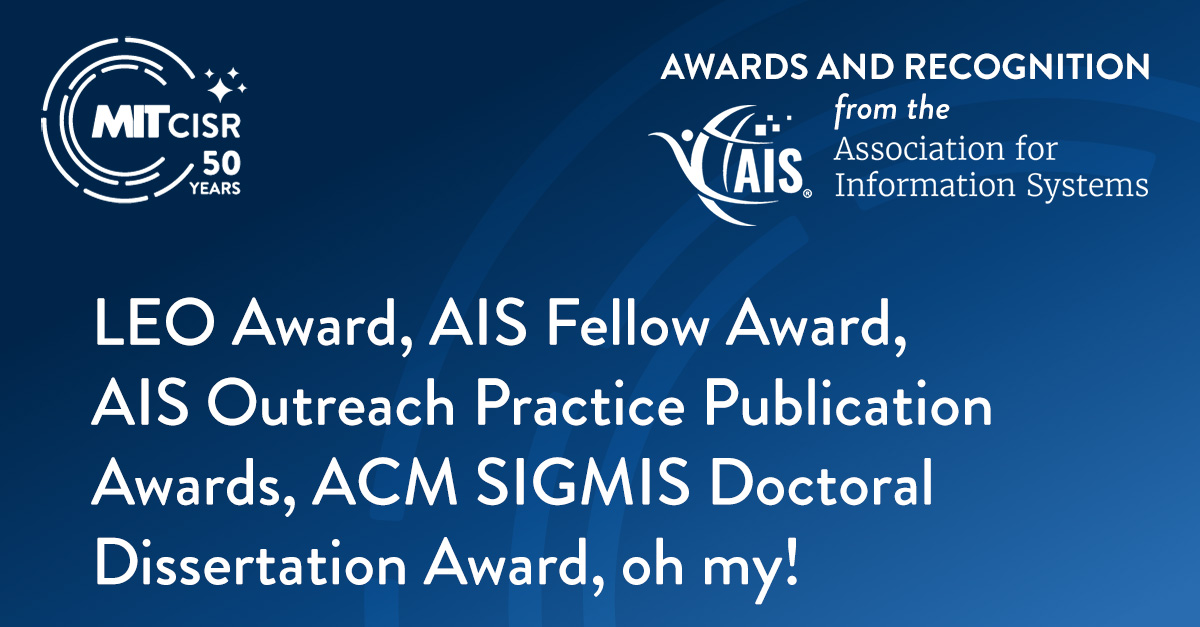
The Association of Information Systems (AIS) is the professional association for individuals and organizations who lead the research, teaching, practice, and study of information systems worldwide. It hosts conferences, supports journals, and and presents awards each year.
Over the years, AIS has honored MIT CISR researchers with several awards.
In 2003, Jack Rockart received a LEO Award. All recipients of the LEO Award, which was established in 1999, are outstanding scholars who have made a global impact on the field of information systems.
In 2017, Jeanne Ross received an AIS Fellow Award recognizing her research on enterprise architecture and her leadership of the 2015 annual International Conference on Information Systems (ICIS). The AIS Fellow Award recognizes individuals who have made outstanding contributions to the information systems discipline in terms of research, teaching, and service.
The AIS Outreach Practice Publication Award was created to recognize members who successfully transfer research to practitioner audiences in practice-based publications. In 2017, Jeanne Ross, Peter Weill, and David Robertson received an AIS Outreach Practice Publication Award for their book Enterprise Architecture and Strategy: Creating a Foundation for Business Execution. In 2023, Barb Wixom received the same award for her book Data Is Everybody’s Business: The Fundamentals of Data Monetization, which she co-authored with Cynthia Beath and Leslie Owens.
In 2015, Martin Mocker, then an MIT CISR research scientist, was recognized with the AIS Best Conference Paper on Education Award for his paper titled “Business-Driven IT Transformation at Royal Philips: Shedding Light on (Un)Rewarded Complexity.” At ICIS 2021, as an academic research fellow with CISR and a professor at Reutlingen University, Mocker was awarded the Best Paper Award at the CIO Forum 2021 for his paper titled "Digital Transformation at Kärcher: Learning to Harness IoT Products for Value Creation."
In 2010, Peter Reynolds, an MIT CISR research scientist at the time, was awarded the ACM SIGMIS Doctoral Dissertation Award for outstanding MIS dissertation for his dissertation titled “The Alignment of Business and IT Strategy in Multi-Business Organizations.”
#MITCISR50th #research #AIS
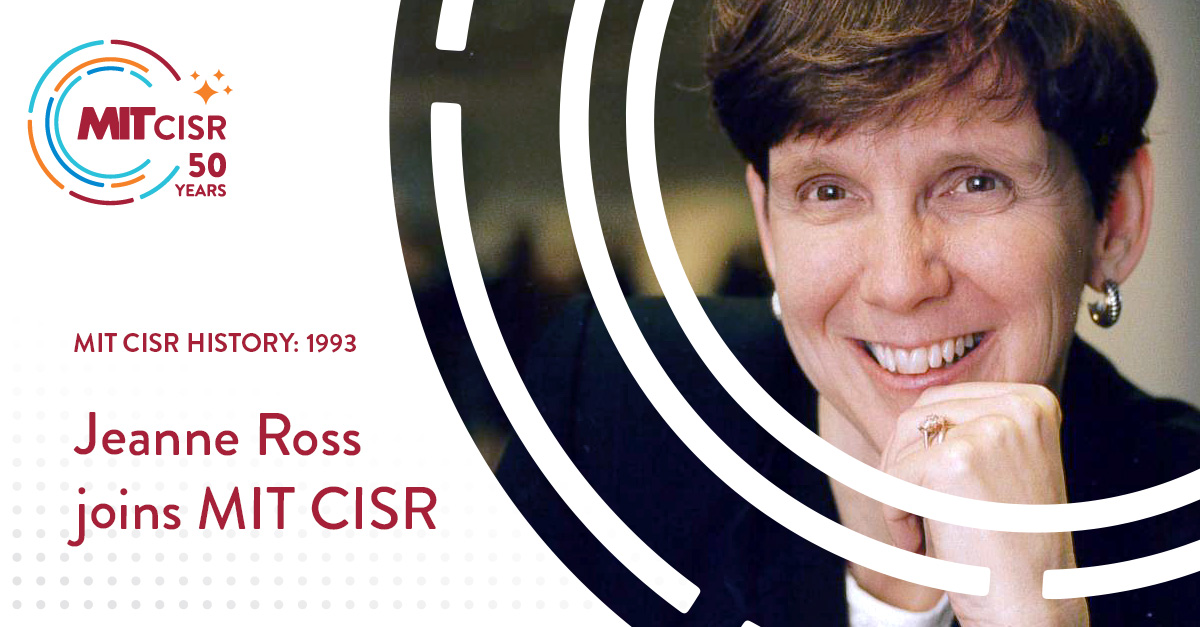
Jeanne Ross began her almost 28-year MIT CISR career in 1993. At the beginning of her tenure she worked closely with Jack Rockart, first as a research scientist and then as a principal research scientist. Jeanne served as director of MIT CISR from 2008–2015; she retired from MIT CISR in 2020. Jeanne is best known for her research on enterprise architecture and on how companies are designing themselves to succeed in the digital economy.
Watch this selection of videos revisiting Jeanne’s years with MIT CISR:
- Jeanne Ross: Career Highlights
- A Tribute to Jeanne Ross
- A Conversation Between Jeanne Ross and Peter Weill
#MITCISR50th #enterprisearchitecture #entarch #EA #operatingmodels #Designed4Digital #D4D #digitization
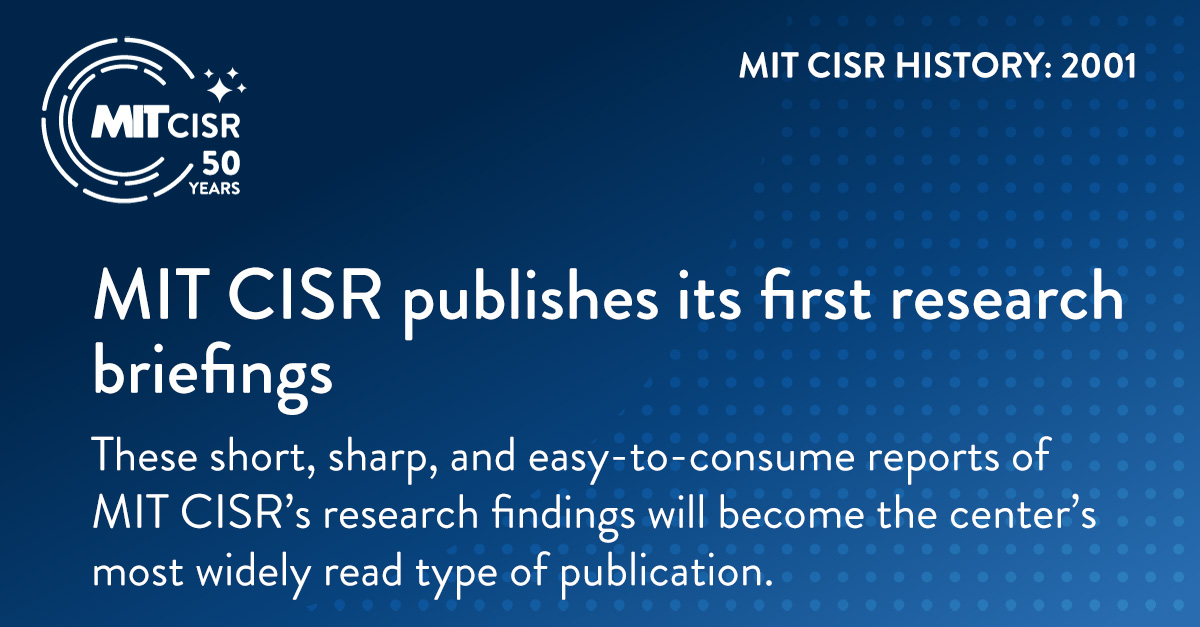
MIT CISR’s first two research briefings were “Atomic e-Business Models” by Peter Weill and Michael Vitale and “When IT Outsourcing Works” by Natalia Levina and Jeanne Ross. Initially, MIT CISR published groupings of several briefings three times per year; in 2009, it switched to publishing individual research briefings monthly. Today, the center also publishes each briefing in an audio version, along with a companion one-page Talking Points summary publication prepared for MIT CISR members.
Review a list of MIT CISR’s research briefings.
#MITCISR50th #research
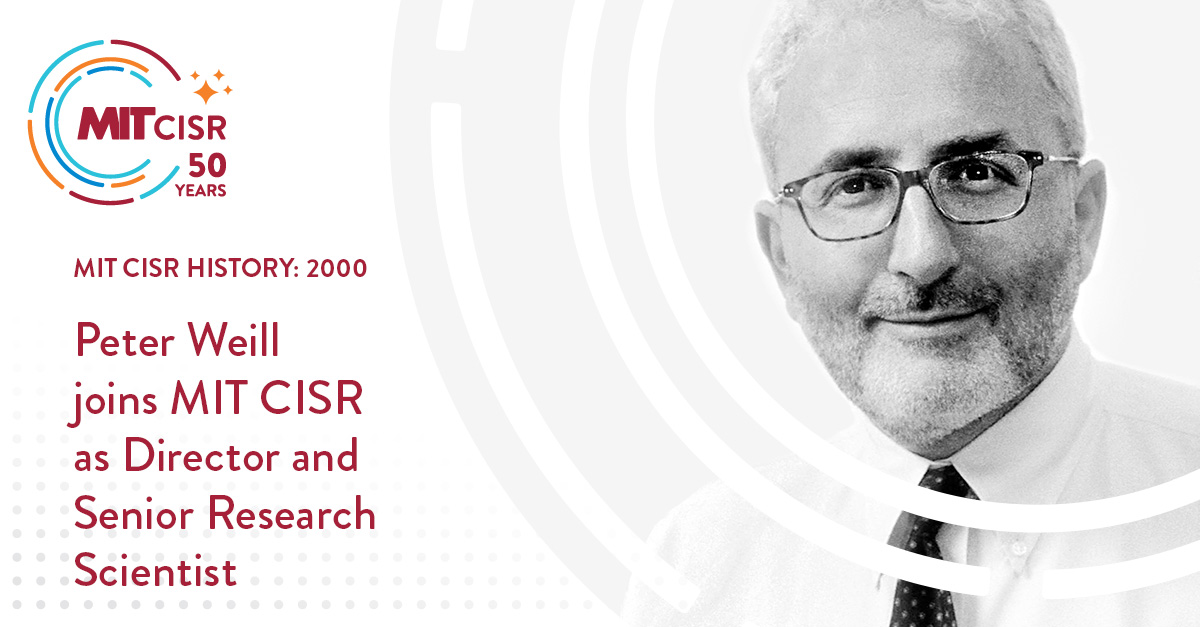
Peter Weill spent a year at MIT CISR as a visiting scholar in 1993. Following Jack Rockart’s retirement in 2000, MIT hired Peter as director of MIT CISR and senior research scientist. Under Peter’s leadership, both the center’s research and its membership base expanded across the globe. After decades of distinguished work at MIT, today Peter serves as Chairman of MIT CISR.
Read about Peter’s accomplishments in his MIT Sloan bio.
#MITCISR50th

MIT CISR faculty members were seeking a way to disseminate information about the excellent research being carried out under the auspices of MIT CISR. They decided to hold a conference where the researchers themselves would spotlight their research, and to do this in the summer when the teaching schedule was light. Slots to attend the conference were automatically assigned to MIT CISR sponsor organizations, while other prospective attendees went through an application process. The first MIT CISR Summer Session was in 1976. The response was huge, and MIT CISR Summer Session became a yearly tradition through 2023.
#MITCISR50th #research

John F. "Jack" Rockart was appointed the Director of MIT CISR in 1976, when the first director, Michael Scott Morton, became an associate dean at the Sloan School. Jack led CISR until 2000 and remained involved in the work of the Center until his death in 2014. Jack had an amazing gift for bridging academic research and real-world problems, and for mentoring junior faculty and students. During his tenure, MIT CISR’s reputation and impact grew across academia and the business world.
Learn more about Jack Rockart on Wikipedia.
#MITCISR50th
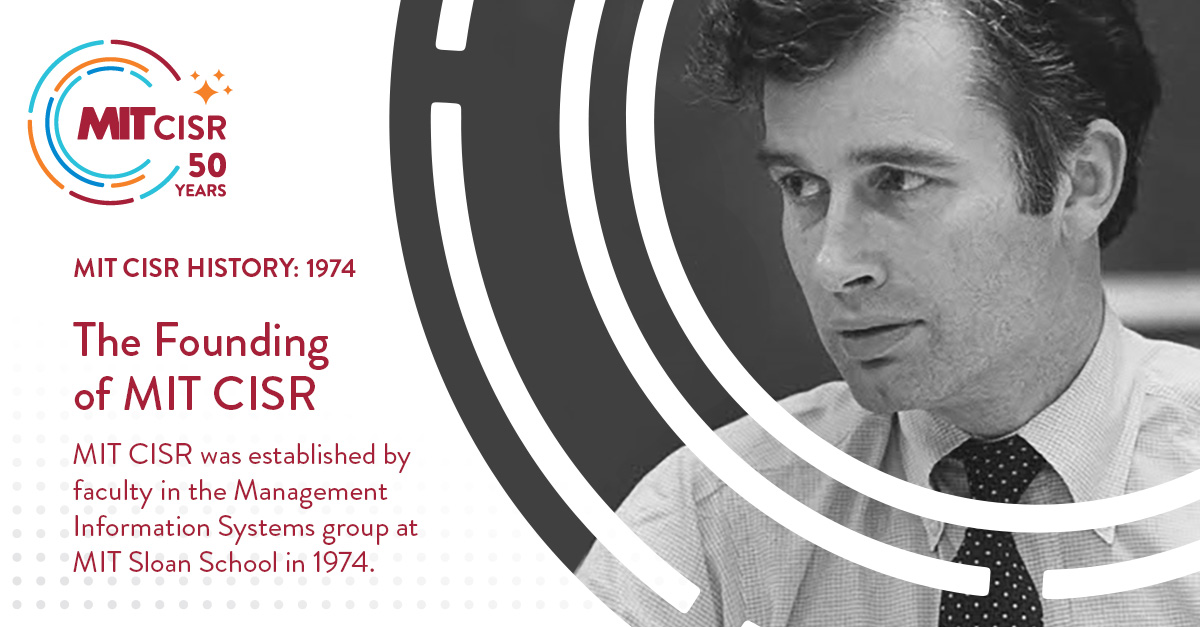
The MIT Center for Information Systems Research (MIT CISR) was established in 1974—50 years ago! It was founded by faculty in the MIT Sloan School’s Management Information Systems group who saw a need for objective, applied research on “significant managerial problems in the utilization of computer-based information systems” and an opportunity to create a consortium of private and public sector sponsors interested in participating in such research. Professor Michael Scott Morton (pictured adjacent, with MIT Sloan bio here) was the first director of MIT CISR.
Read the center's original Statement of Purpose and Structure.
#MITCISR50th #computer #informationsystems #research